Rare flowers and golden butterflies
Stories of women and magic from the Australian Performing Arts Collection, Arts Centre Melbourne
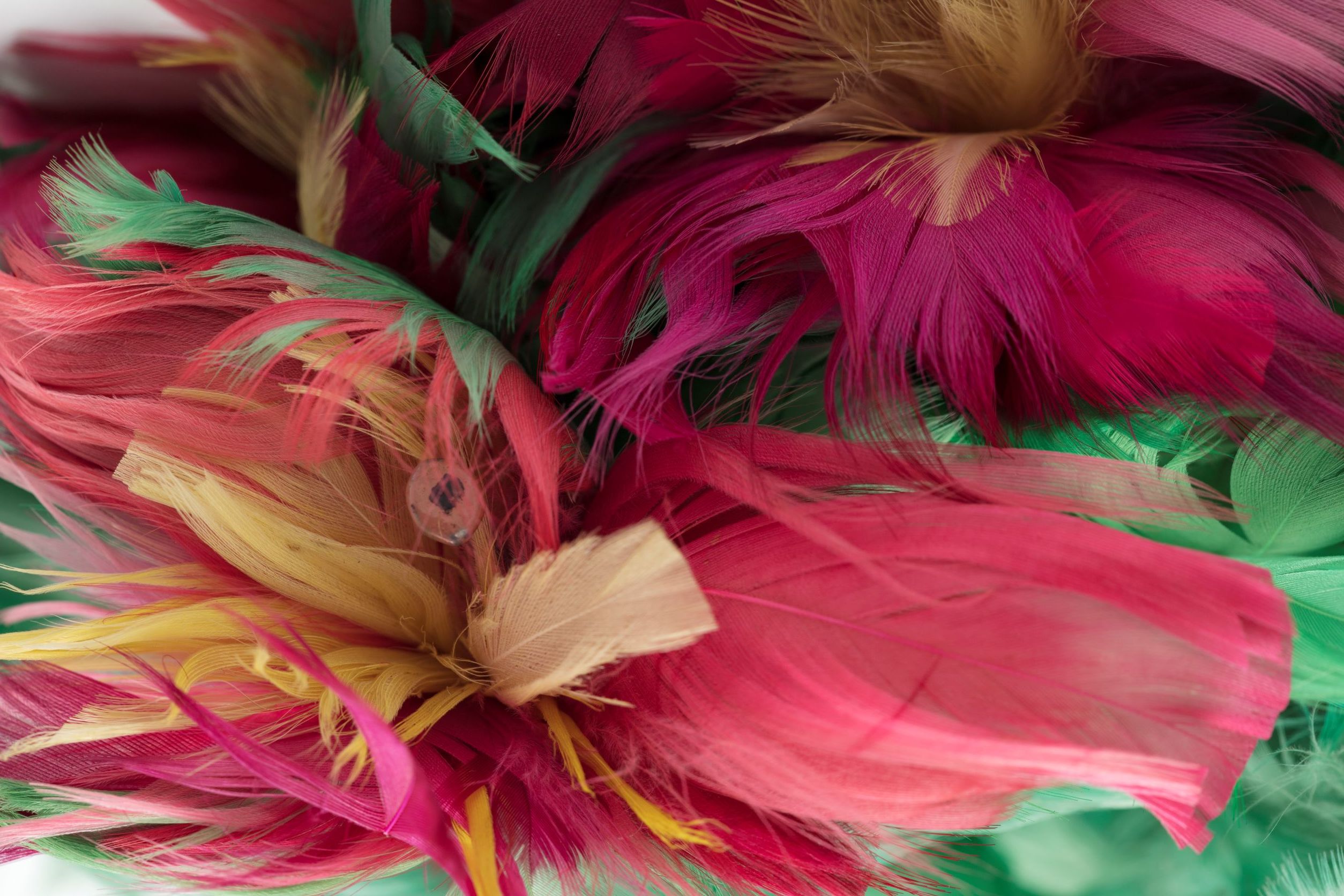
In 1938 a teenager stood on a high diving board in handcuffs and leg irons joined by thick metal chains.
The scene was a magicians' convention at Malvern, a spa town in the English Midlands.
The girl who was about to be propelled into the pool below was a 16-year-old Australian called Esme Levante.
The jump, and subsequent escape act, drew a large crowd, and a newsreel that captured the event intoned with mock gravitas:
"Illusionists do awful things to women.
"They make them disappear, saw them in half, and now they are drowning one."
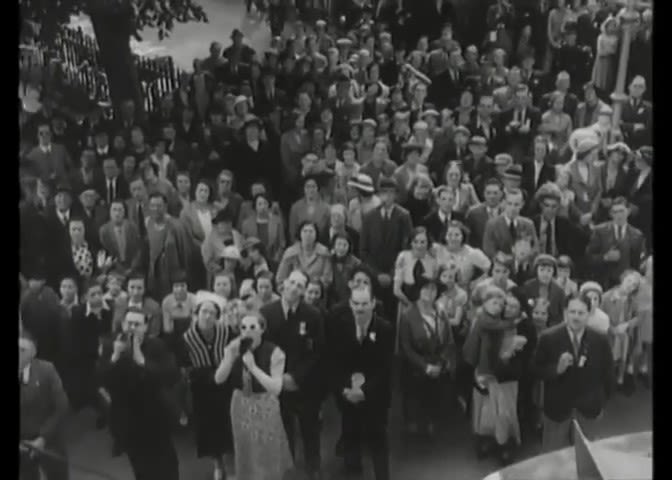
Esme didn't drown, of course, and instead came to the surface, brandishing her chains in the air, triumphant.
Yet the narrative of a helpless woman being a foil to the main act is an age-old trope in the field of magic.
From the moment English magician P. T. Selbit first sawed a woman in half on stage 100 years ago this year, women and their bodies have been fair game for the showmanship on display.
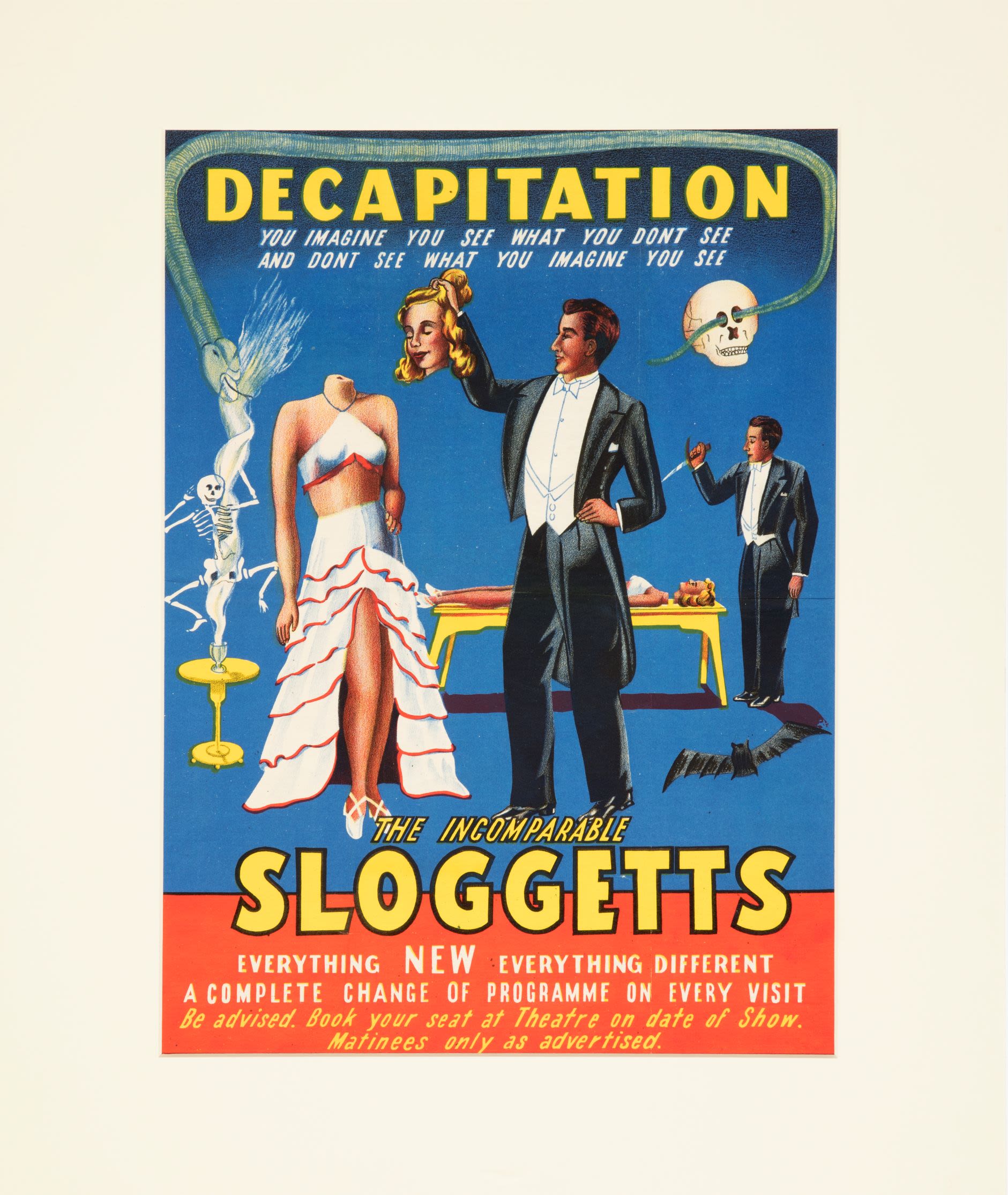
Poster advertising the Incomparable Sloggetts, circa 1930-1940, the Australian Performing Arts Collection
Poster advertising the Incomparable Sloggetts, circa 1930-1940, the Australian Performing Arts Collection
What is less understood, however, is the role women have played in the development of magic over the years.
Tucked away in the archives of the Australian Performing Arts Collection at the Arts Centre Melbourne are the stories of three women - Esme Levante, Myrtle Roberts and Moi-Yo Miller - who all contributed to the development of magic performance at a time when the art form was predominately seen as a male affair.
Each with their own story to tell, they deserve their time in the spotlight.
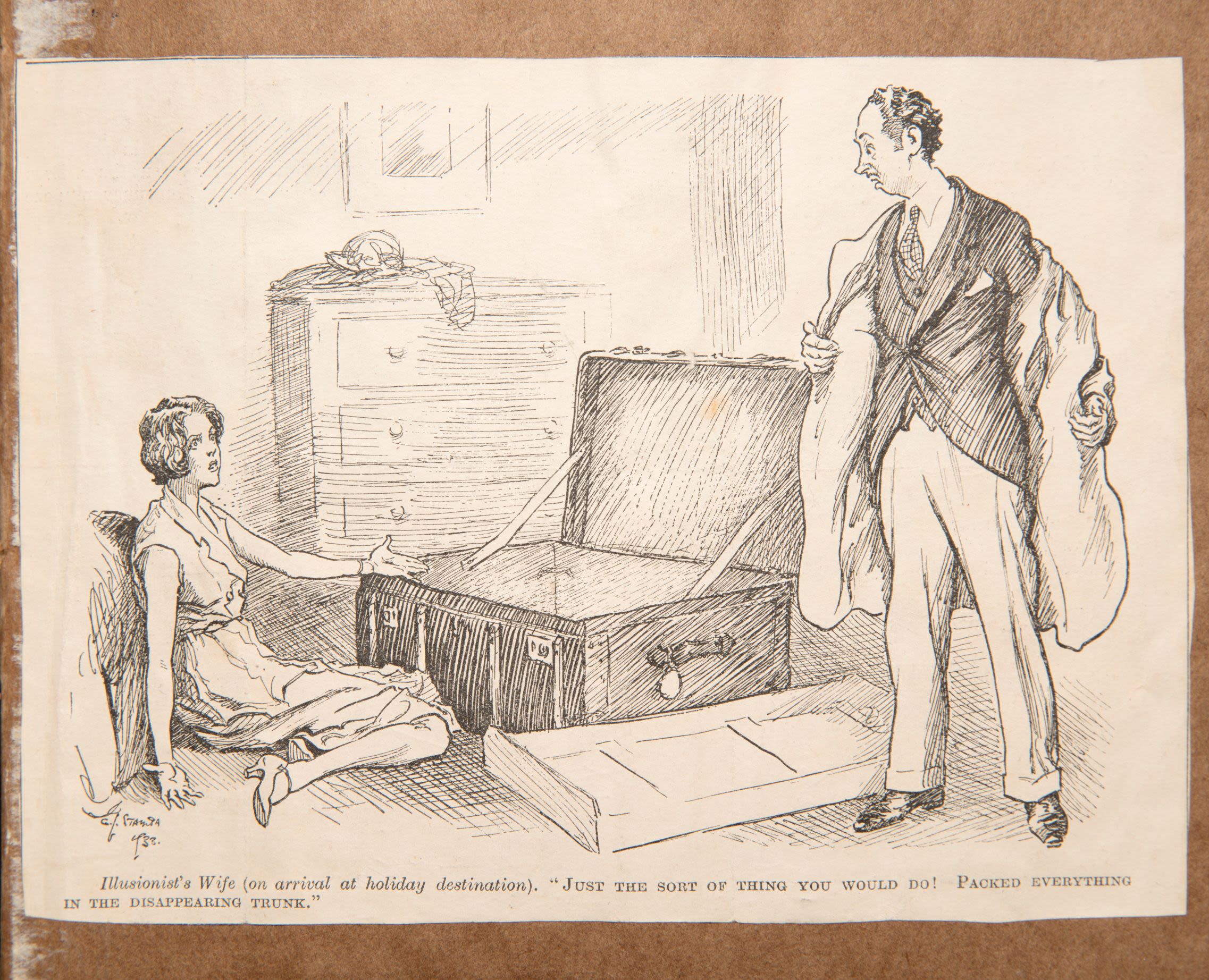
Illusionist's Wife (on arrival at holiday destination). "Just the sort of thing you would do! Packed everything in the disappearing trunk." Cartoon in scrapbook belonging to magician Claude Guest, Australian Performing Arts Collection
Illusionist's wife (on arrival at holiday destination) "Just the sort of thing you would do! Packed everything in the disappearing trunk." Cartoon in scrapbook belonging to magician Claude Guest, Australian Performing Arts Collection
Esme Levante
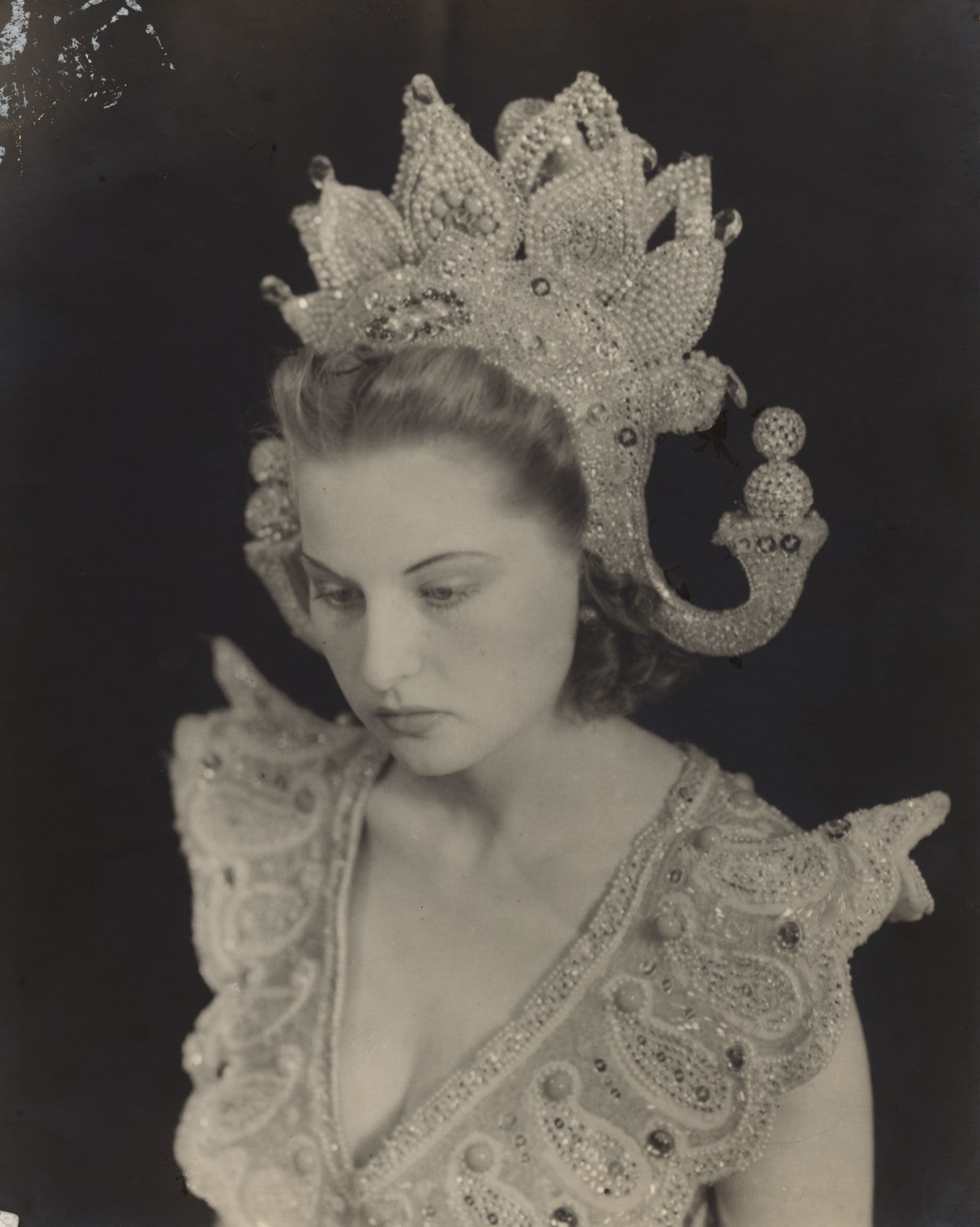
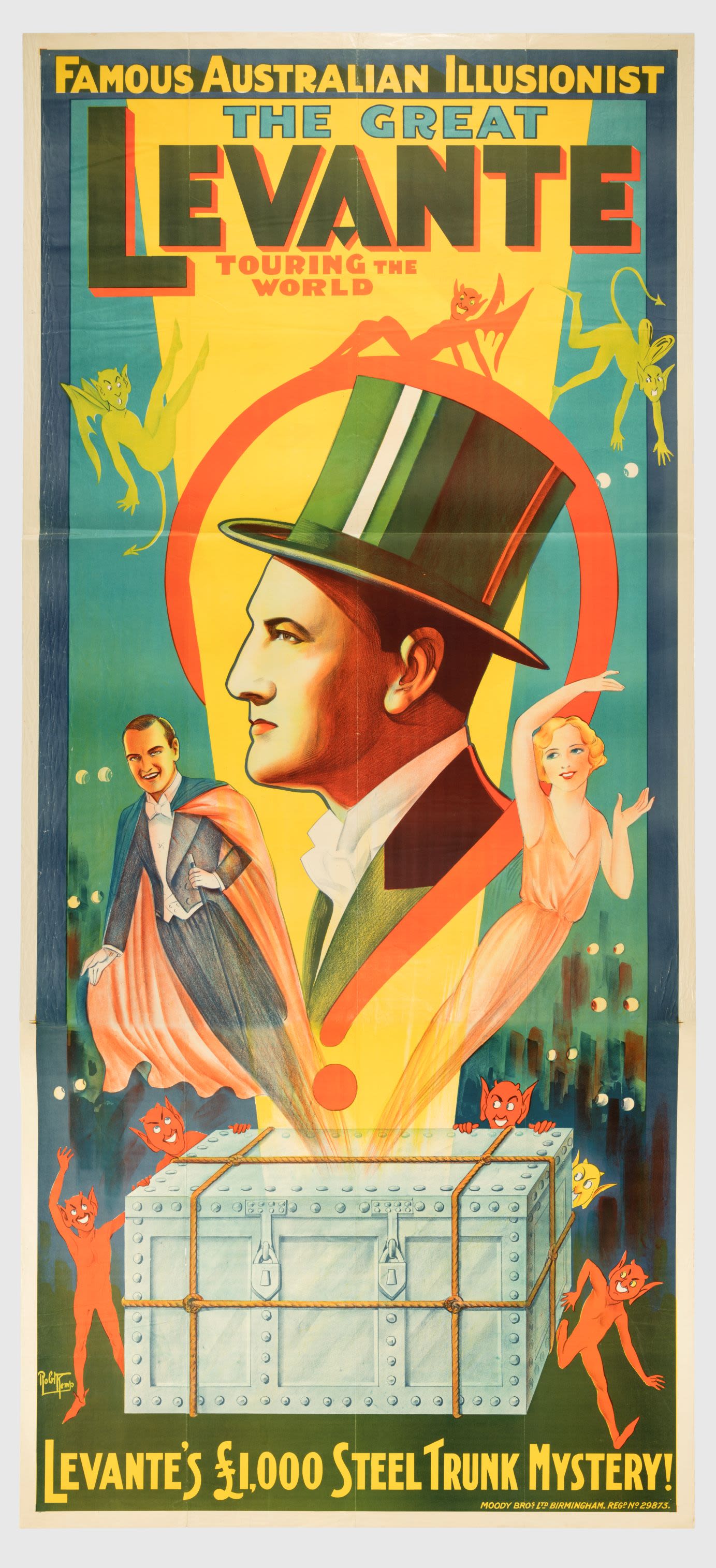
Australian Performing Arts Collection
Australian Performing Arts Collection
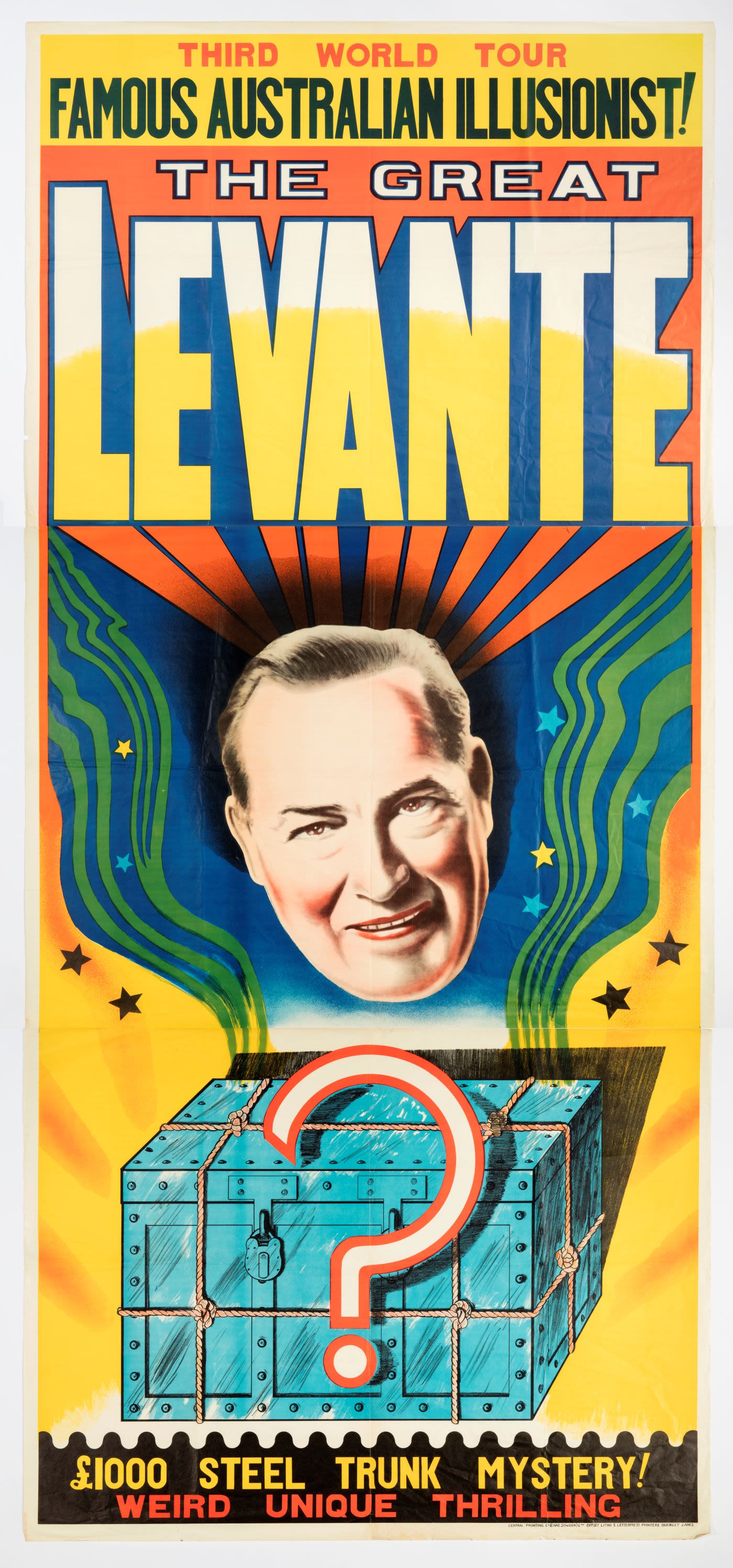
Australian Performing Arts Collection
Australian Performing Arts Collection
Esme Levante's career has for decades been overshadowed by her more famous father Les Cole who, under the stage name the Great Levante, was one of Australia's most successful magicians last century.
What is less well known is that Esme had a successful career of her own as an escapologist, magician and cabaret performer. Her years on stage spanned more than four decades.
Born Esme Ray Cole in November 1921, she travelled as an infant throughout Australia with her father and mother Gladys, a long distance swimmer from Brisbane who Les had first laid eyes on during Armistice Day celebrations in 1918.
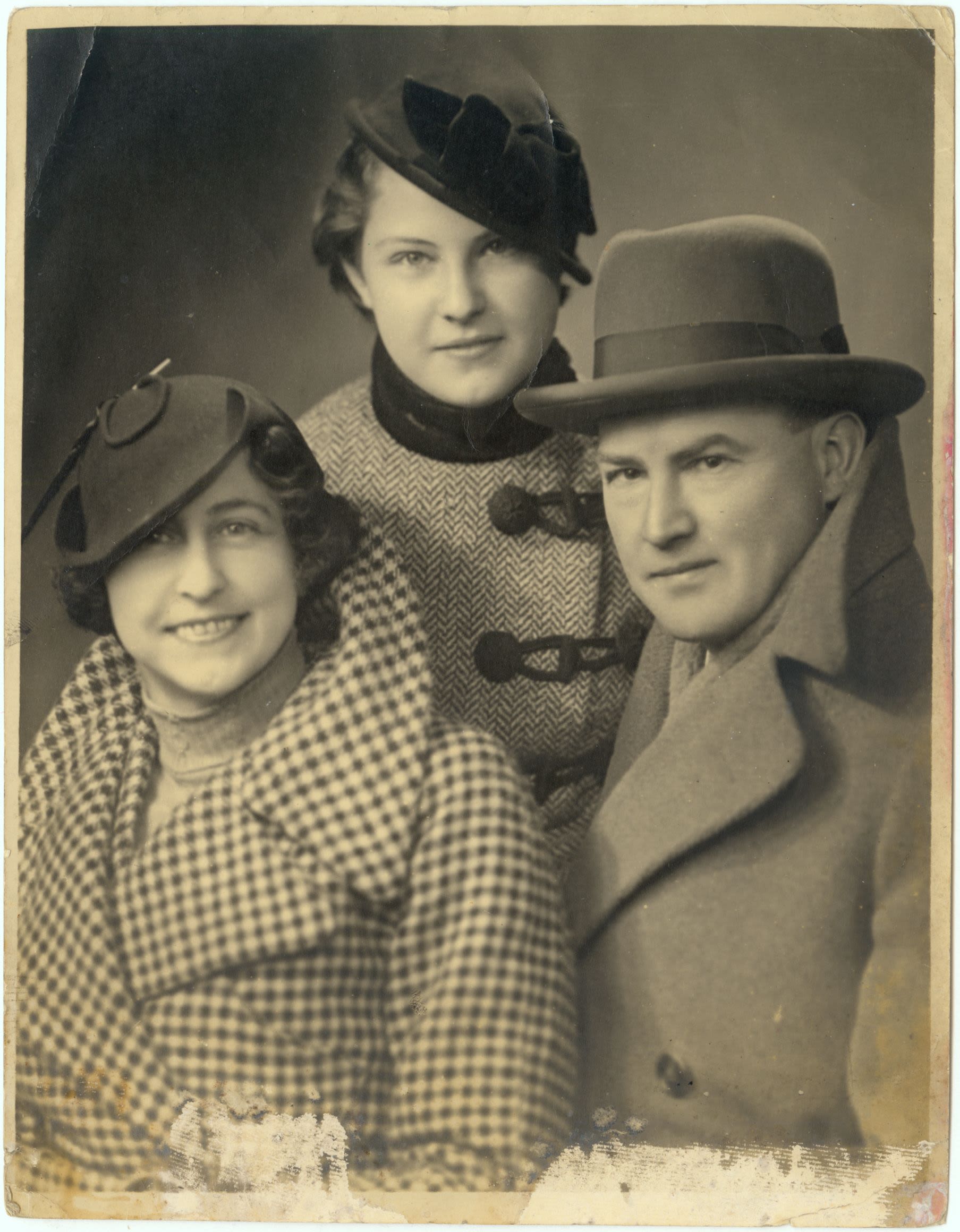
A family portrait of Gladys, Esme and Les Cole, 1937, Australian Performing Arts Collection
A family portrait of Gladys, Esme and Les Cole, 1937, Australian Performing Arts Collection
Magic historian Kent Blackmore, who wrote a biography on the Great Levante called Levante: His Life no Illusion, says although her role is often hidden on the posters and in the press clippings of the day, Gladys was integral to her husband's success.
She performed the piano accordion and perfected the art of hand shadows using the stage names Harlequin Lady of Shadows or Madame Costin. She was also her husband's main assistant and was no slouch when it came to putting Les in his place.
"The story goes that at one stage in the 1920s Les's main trick was doing the brand new sawing a woman in half routine that everyone in the world was starting to copy.
"Gladys was the assistant being sawn in half, and she wasn't reticent about talking to her husband on stage.
"She was being sawn in half and was saying 'For Christ's sake Les, Esme is off stage crying in the bassinette. Hurry up with the trick, get on with it!'"
By the time Esme was five, she too would join her parents on stage.
While the social mores of the day may have dictated a more cloistered life for a young girl, Les had other plans.
His daughter was expected to join the family business and before long she was delighting audiences with her violin playing and marionette dance, or creating pictures out of rags and sand, both popular vaudeville acts of the day.
In the late 1920s, the Great Levante decided to try his luck abroad. The small family and their performing troupe snaked their way through Asia, performing in town halls and gymnasiums to appreciative audiences.
The local newspapers lauded “Esme Ray the child phenomenon", who was mystifying audiences with her clairvoyant skills, and declared she was a "most accomplished young lady" who had "remarkable powers".
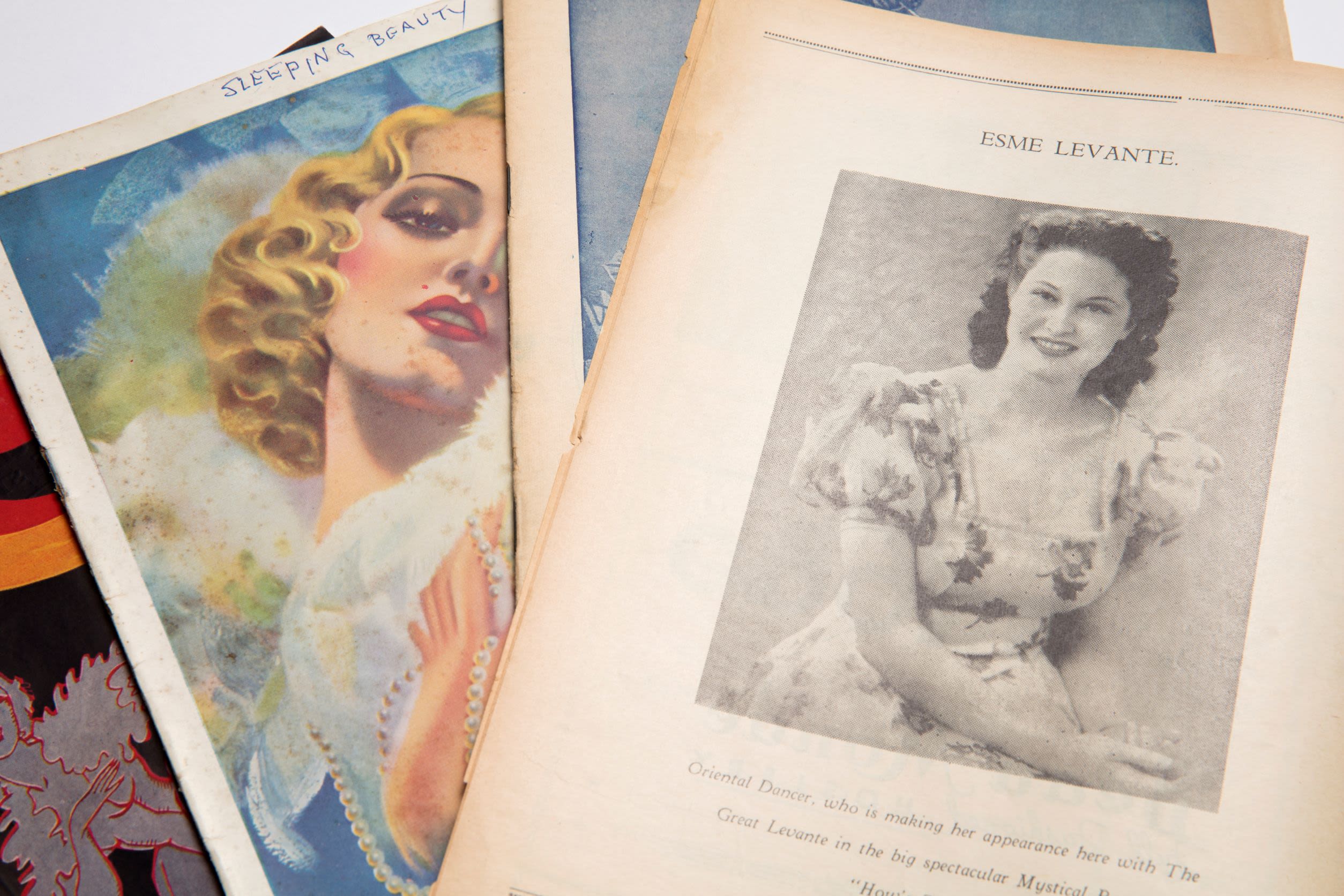
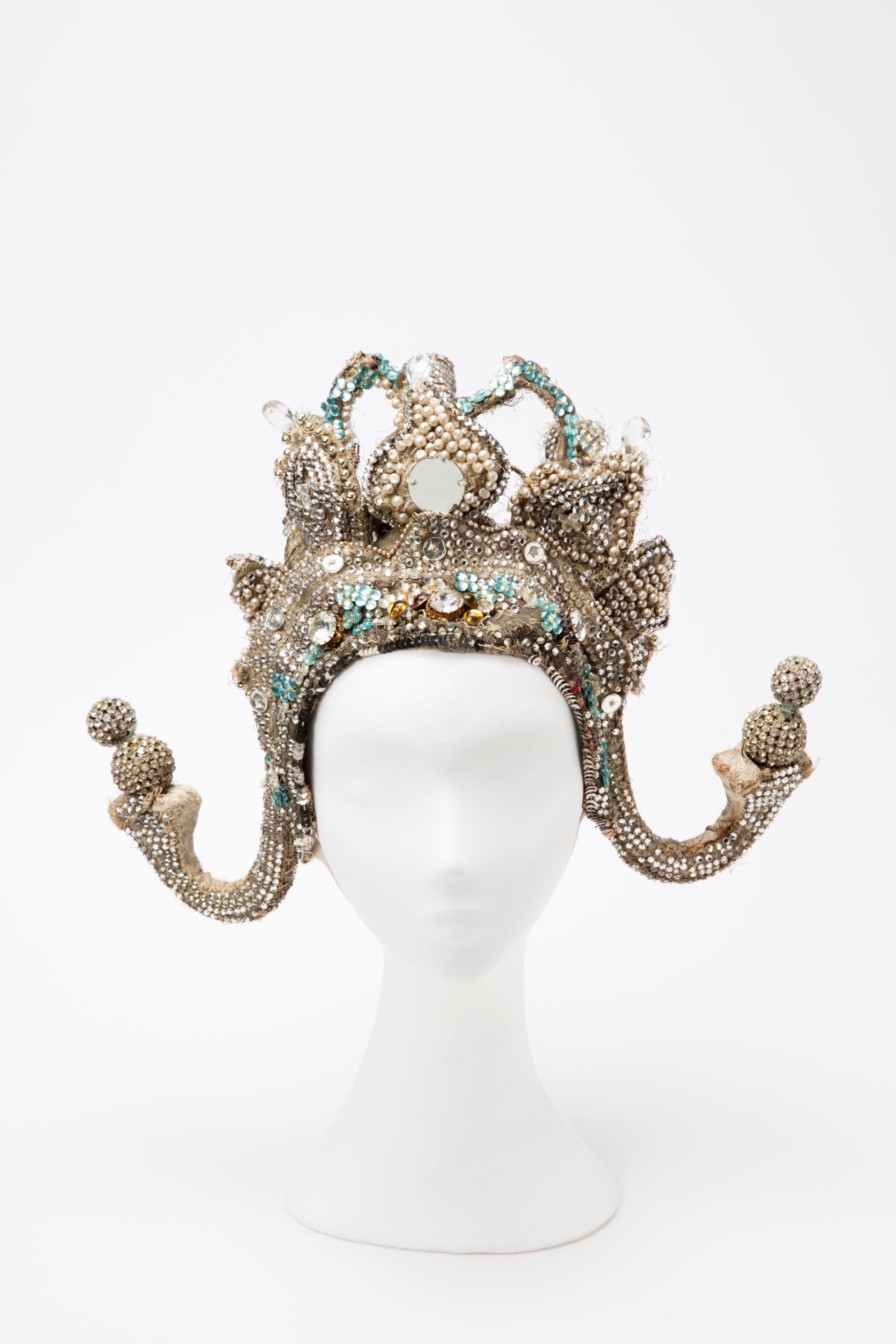
Headdress worn by Esme Levante in How's Tricks, Australian Performing Arts Collection
Headdress worn by Esme Levante in How's Tricks, Australian Performing Arts Collection
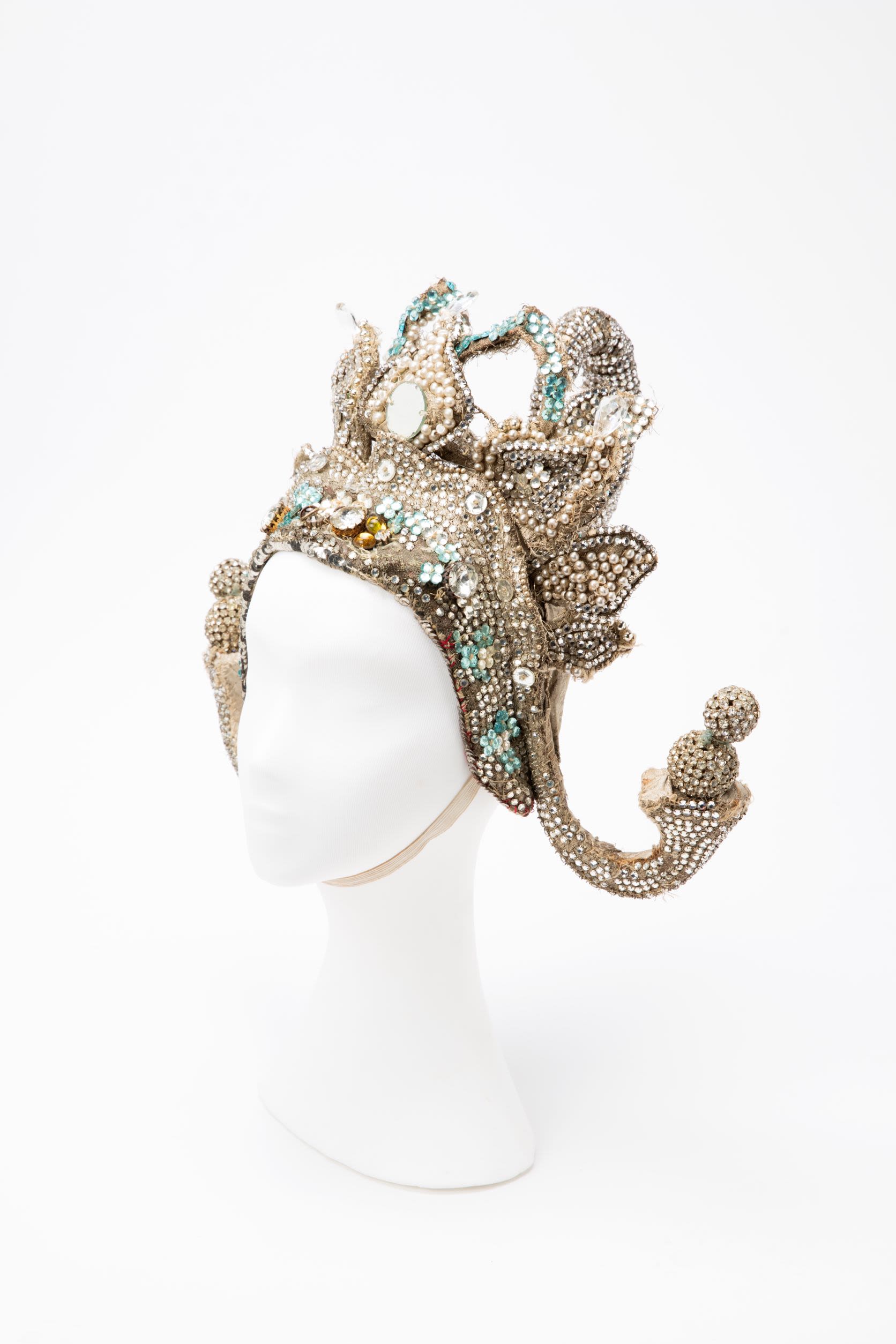
Headdress worn by Esme Levante in How's Tricks, Australian Performing Arts Collection
Headdress worn by Esme Levante in How's Tricks, Australian Performing Arts Collection
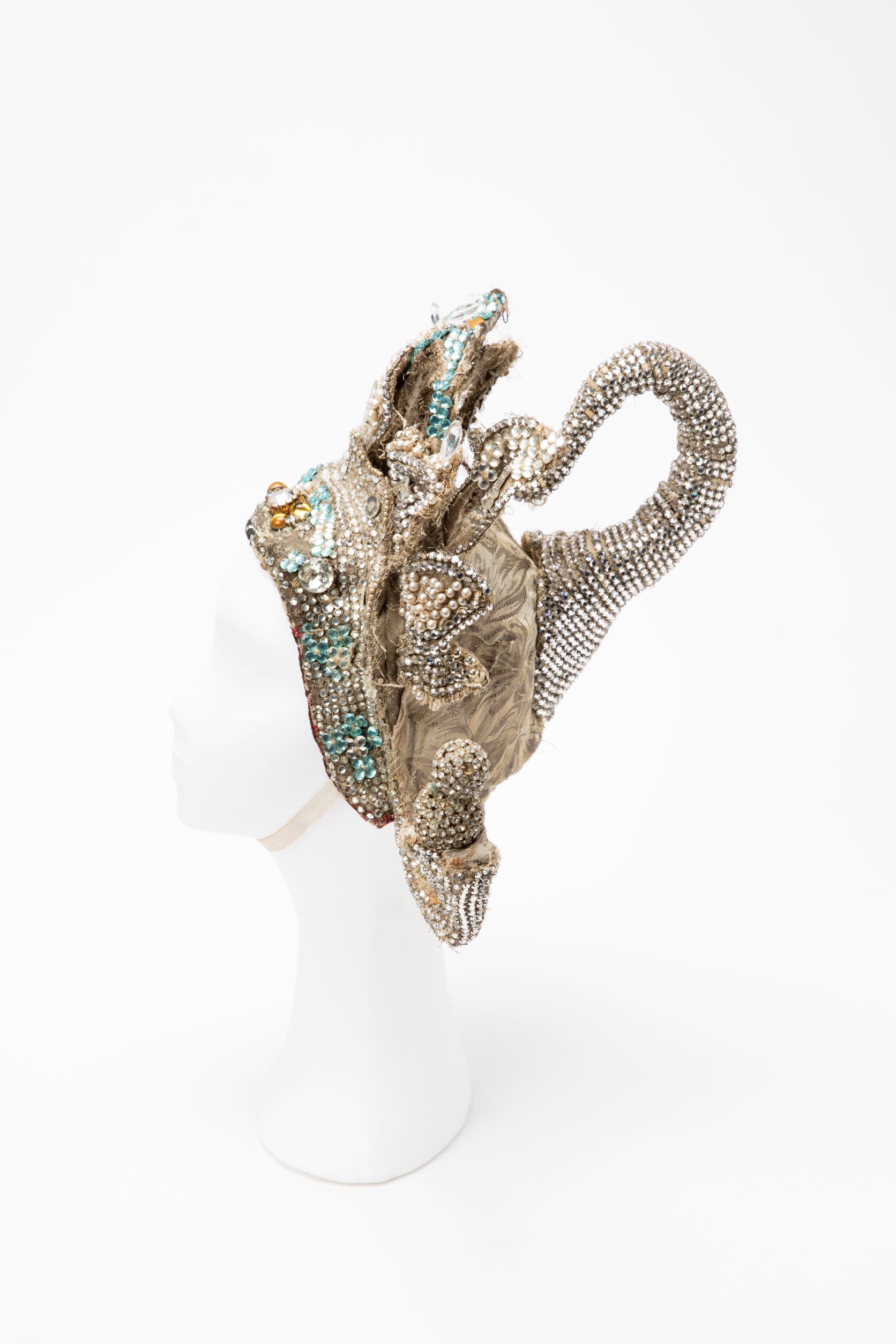
Headdress worn by Esme Levante in How's Tricks, Australian Performing Arts Collection
Headdress worn by Esme Levante in How's Tricks, Australian Performing Arts Collection
The Levantes finally arrived in the UK in 1933 and the Great Levante spent the next four years developing a full scale magic variety show called How’s Tricks. When it opened in 1937 it was an immediate hit, and was a show that would make him famous.
Esme would rise through the ranks to be her father's main assistant, taking over from her mother Gladys in some of his more famous illusions. She would trade places with her father in his famous padlocked trunk trick and, wearing an elaborate headdress and beaded bodice, have swords thrust through her in an illusion called Pillars of Fear.
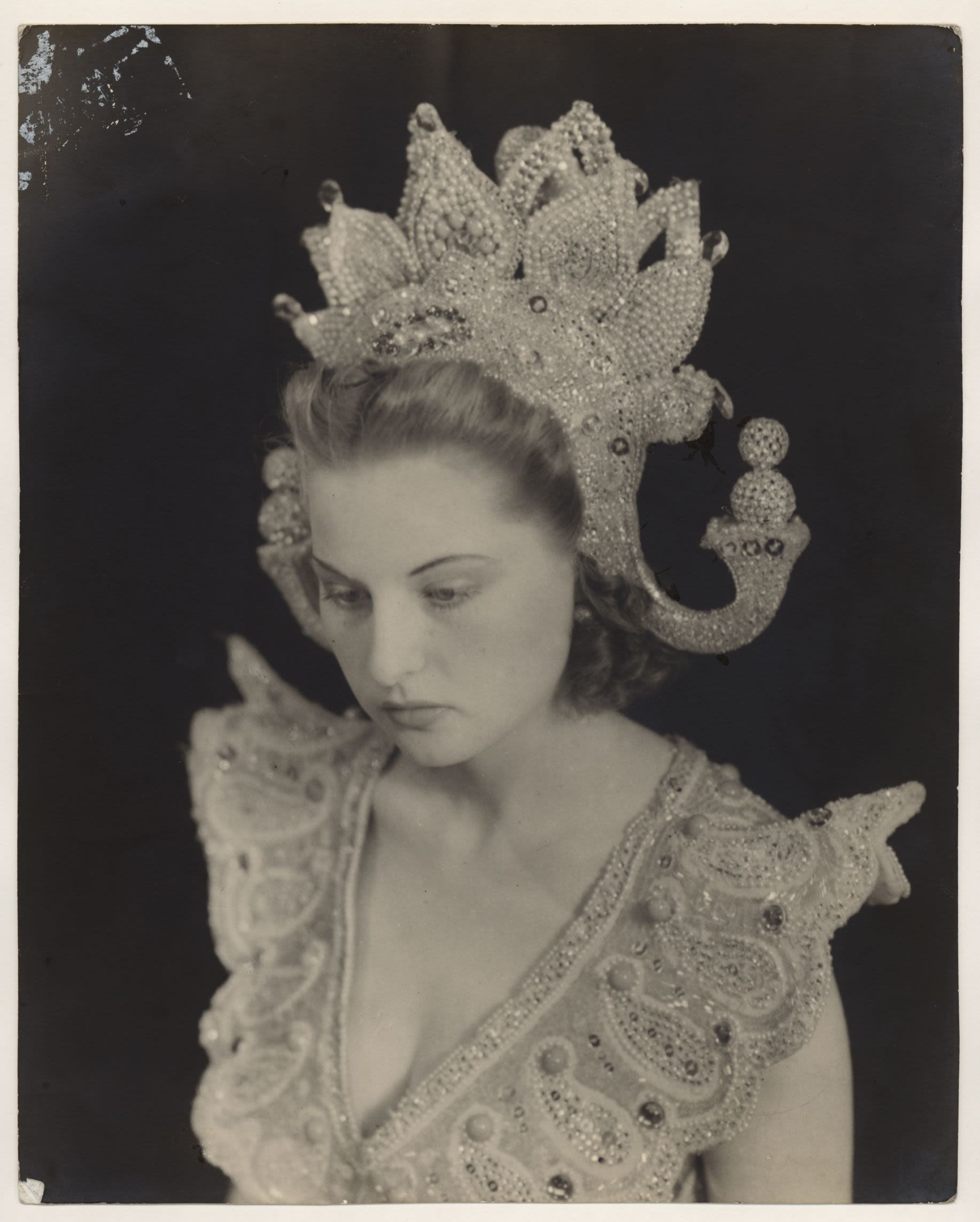
Esme Levante in How's Tricks, 1940, from Will Alma Collection, State Library of Victoria
Esme Levante in How's Tricks, 1940, from Will Alma Collection, State Library of Victoria
Publicity for the show declared that Esme was "the most daring girl in the world!"
However Maxwell Hunt, Esme’s son, is uncertain whether his mother always enjoyed her theatrical upbringing.
The outbreak of WWII saw the Levantes return to Australia in 1940 to stage How's Tricks for the JC Williamson theatre company. Esme, now in her late teens, was yearning for her own life.
"When she got to be a bit older she wanted to escape, she wanted to have some independence," Hunt explains. "Marrying my father enabled her to get away."
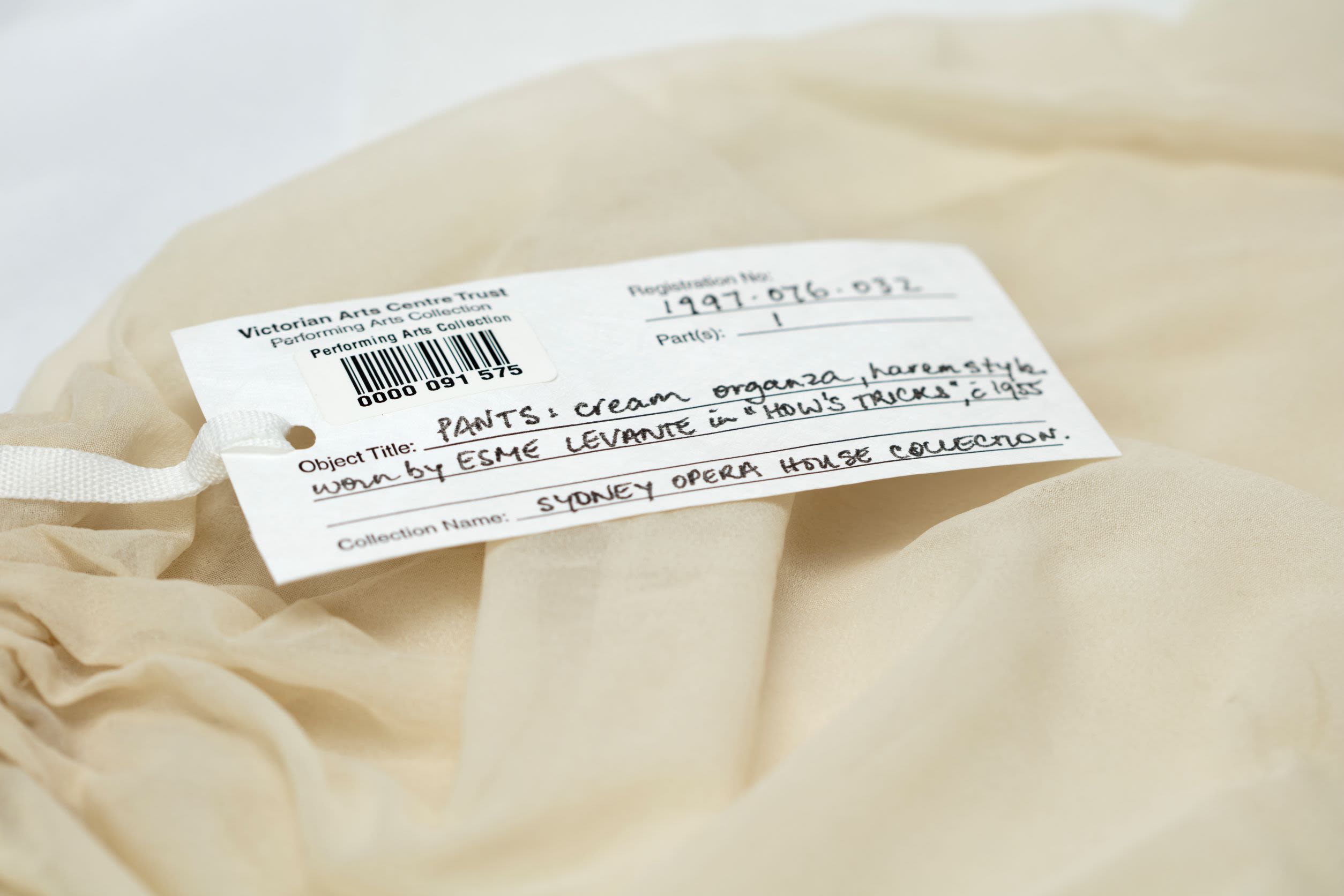
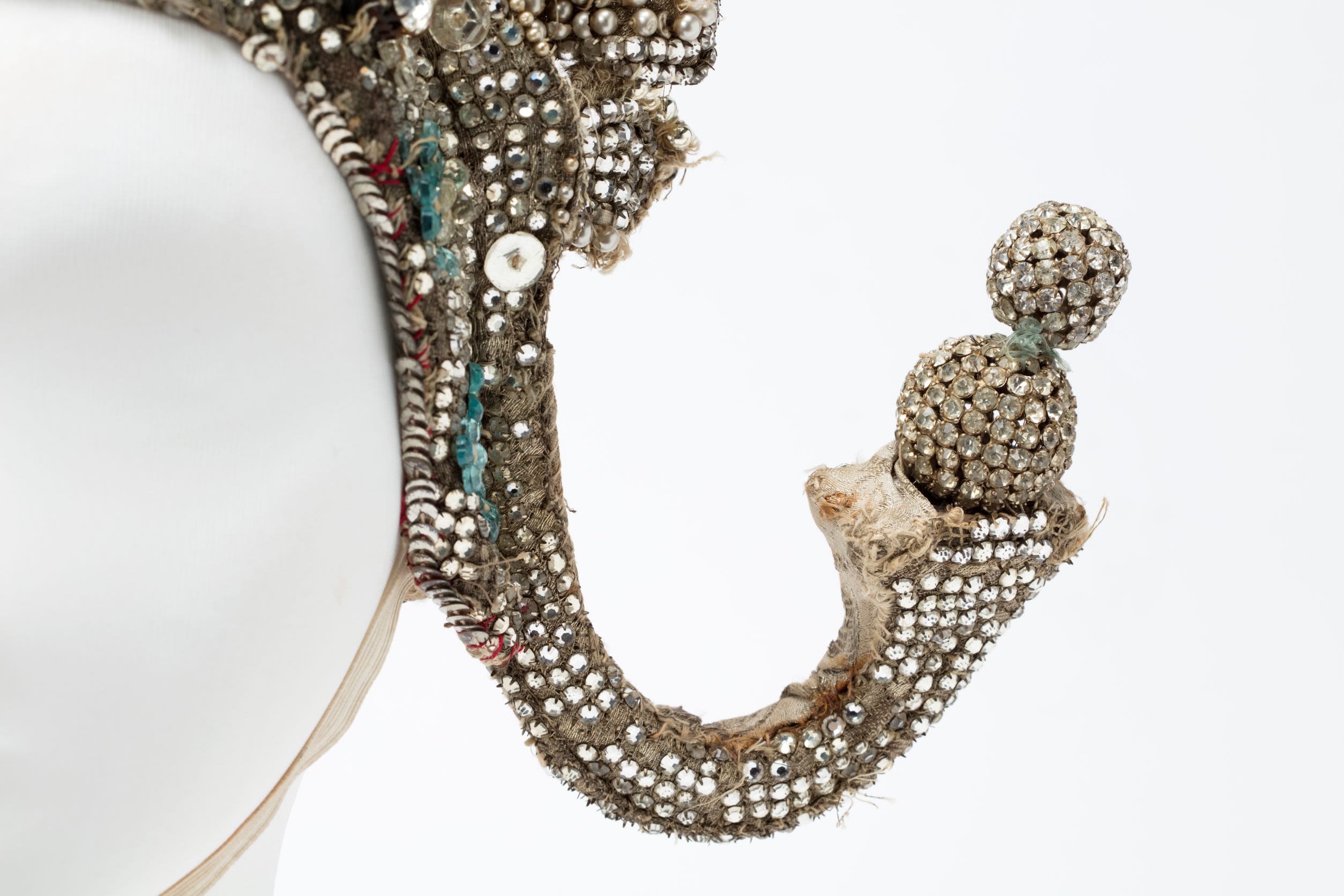
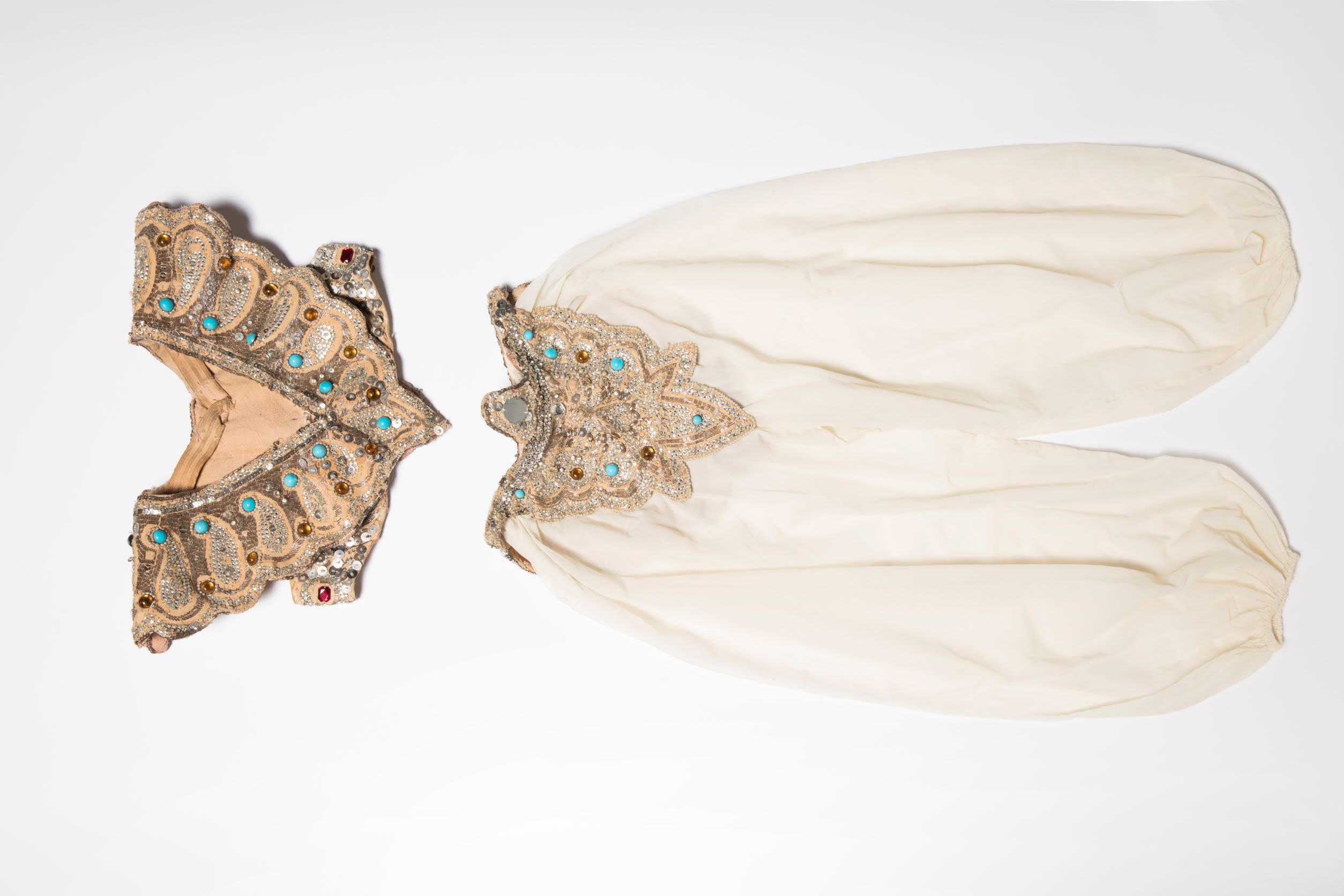

Detail of Esme Levante's organza harem pants worn in How's Tricks, Australian Performing Arts Collection
Detail of Esme Levante's organza harem pants worn in How's Tricks, Australian Performing Arts Collection

Detail of Esme Levante's headdress worn in How's Tricks, Australian Performing Arts Collection
Detail of Esme Levante's headdress worn in How's Tricks, Australian Performing Arts Collection

Costume worn by Esme Levante in How's Tricks, circa 1940-1955, Australian Performing Arts Collection
Costume worn by Esme Levante in How's Tricks, circa 1940-1955, Australian Performing Arts Collection
Yet even Esme's wedding in November 1941 to stage manager Robert Butt was a carefully staged affair. Ever the showman, the Great Levante arranged for the wedding to take place on stage at the Tivoli in Adelaide before a delighted live audience.
Magazines such as Pix lapped it up with pages dedicated to a day in the life of the bride who had spent the first part of her wedding day having “a sword run through her in one of Levante’s most popular illusions”.
"Magician Levante used his magic kettle. He delighted guests by producing from it champagne, beer, brandy, cocktails, wines", Pix declared, adding Esme was a “ballet mistress, soubrette, violinist and illusion girl” who “hopes to become one of the world’s few women magicians”.
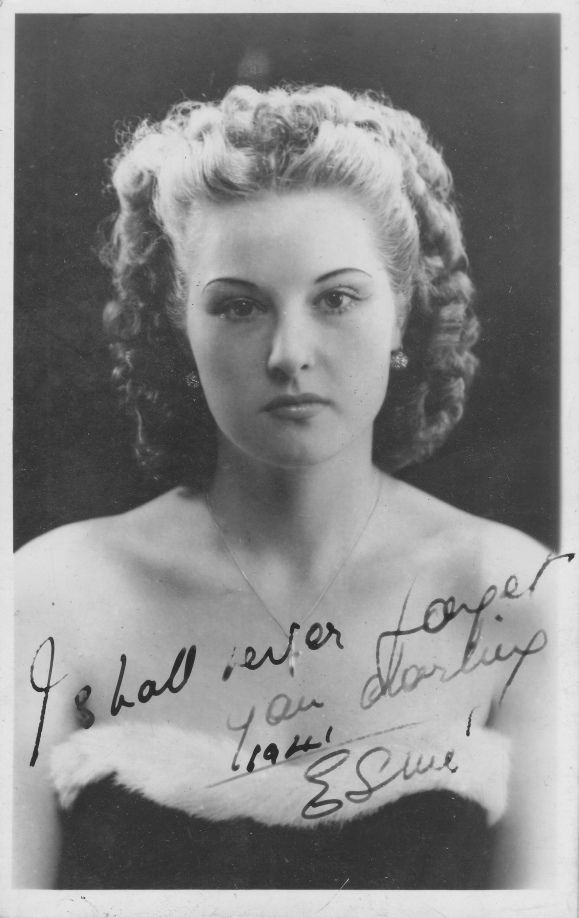
'I shall never forget you darling', Esme, 1941 (courtesy of Maxwell Hunt)
'I shall never forget you darling', Esme, 1941 (courtesy of Maxwell Hunt)
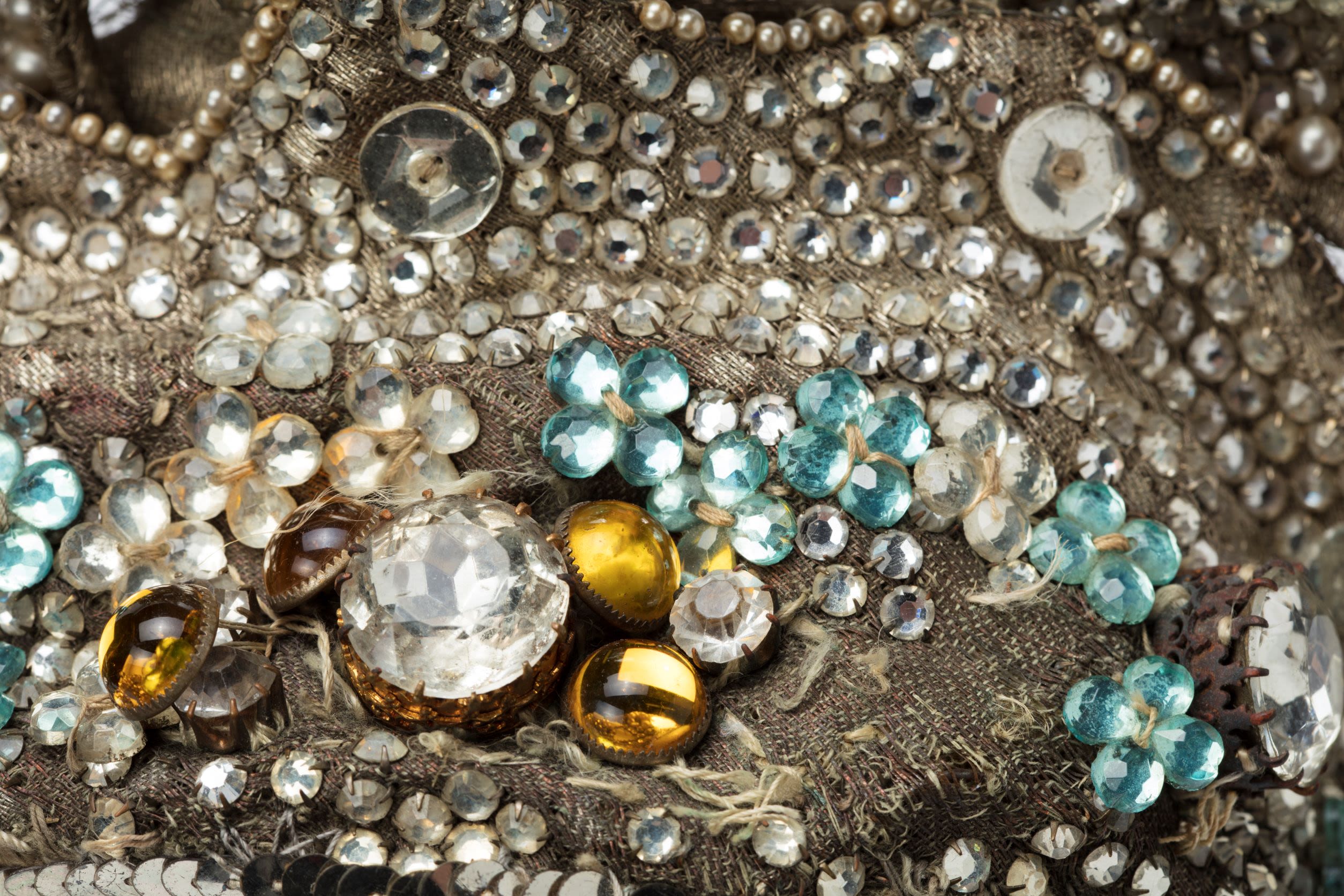
Myrtle Roberts
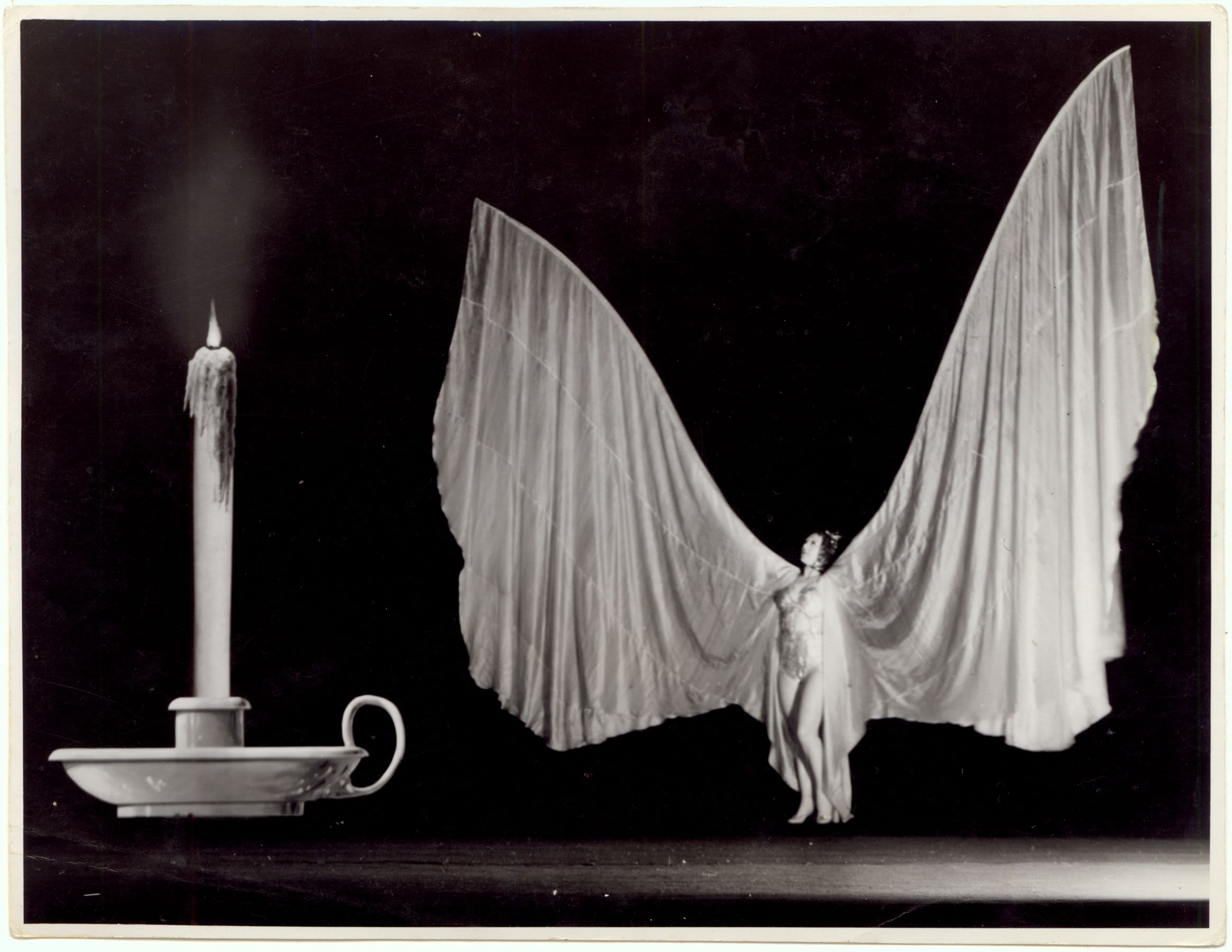
Certainly Esme Levante's positioning as a future female magician put her in rare company, but she was not the only woman making a mark in magic at the time.
In Melbourne, Myrtle Roberts was using a mix of vaudeville and magic to create her own persona, with business cards that read "Australia's Foremost Lady of Magic".
Born in January 1908 in Brunswick East, Myrtle said in an interview with Melbourne's Herald in 1971 that she took dancing lessons in Nicholson Street as a young girl in the 1920s, and often passed illegal two up games and underworld figure “Squizzy” Taylor on her way home.
Like many other young women of her generation, Myrtle started her working life as a machinist but said “I didn’t want to spend the rest of my life sitting on my bottom, so I decided to learn to sing and dance”.
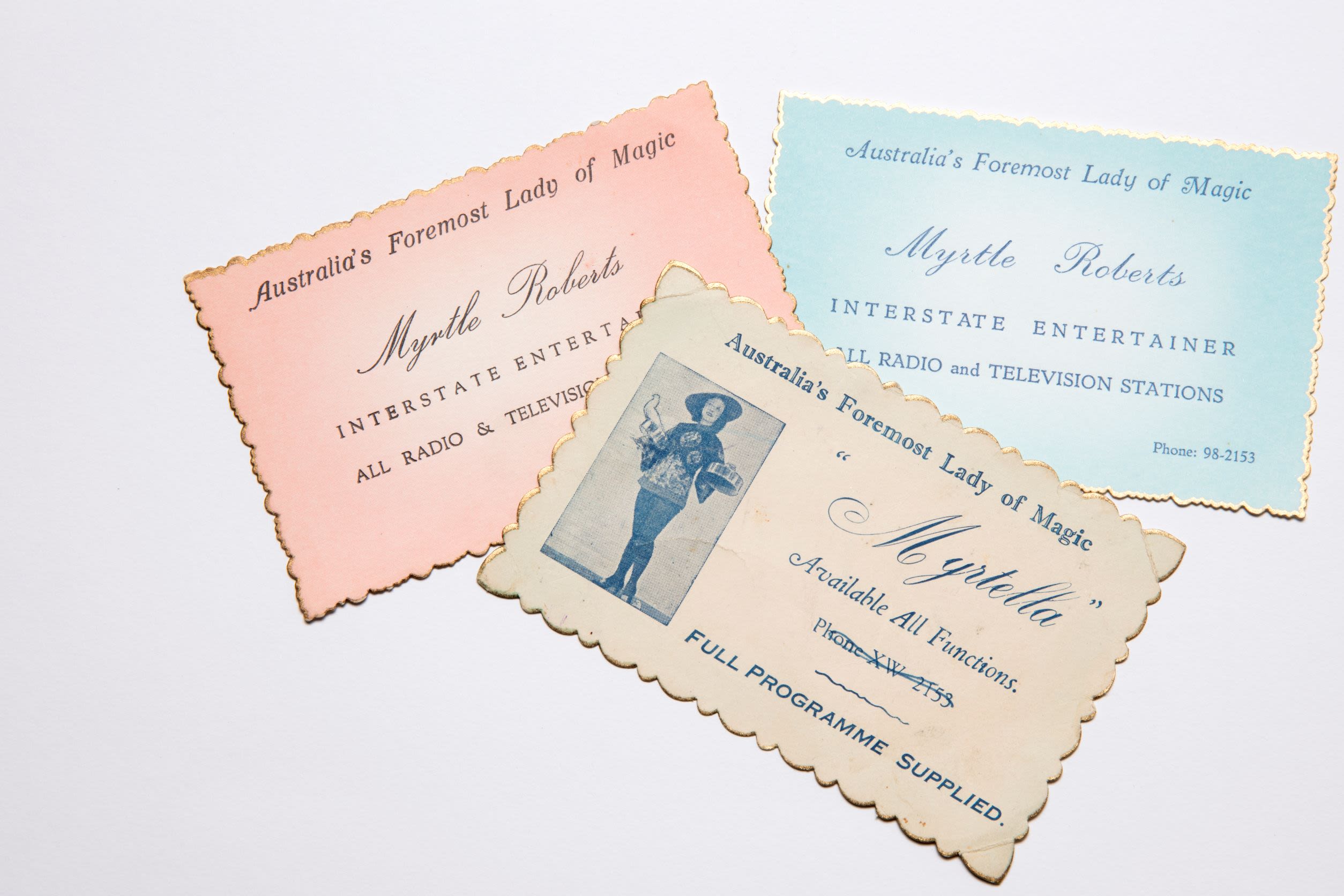
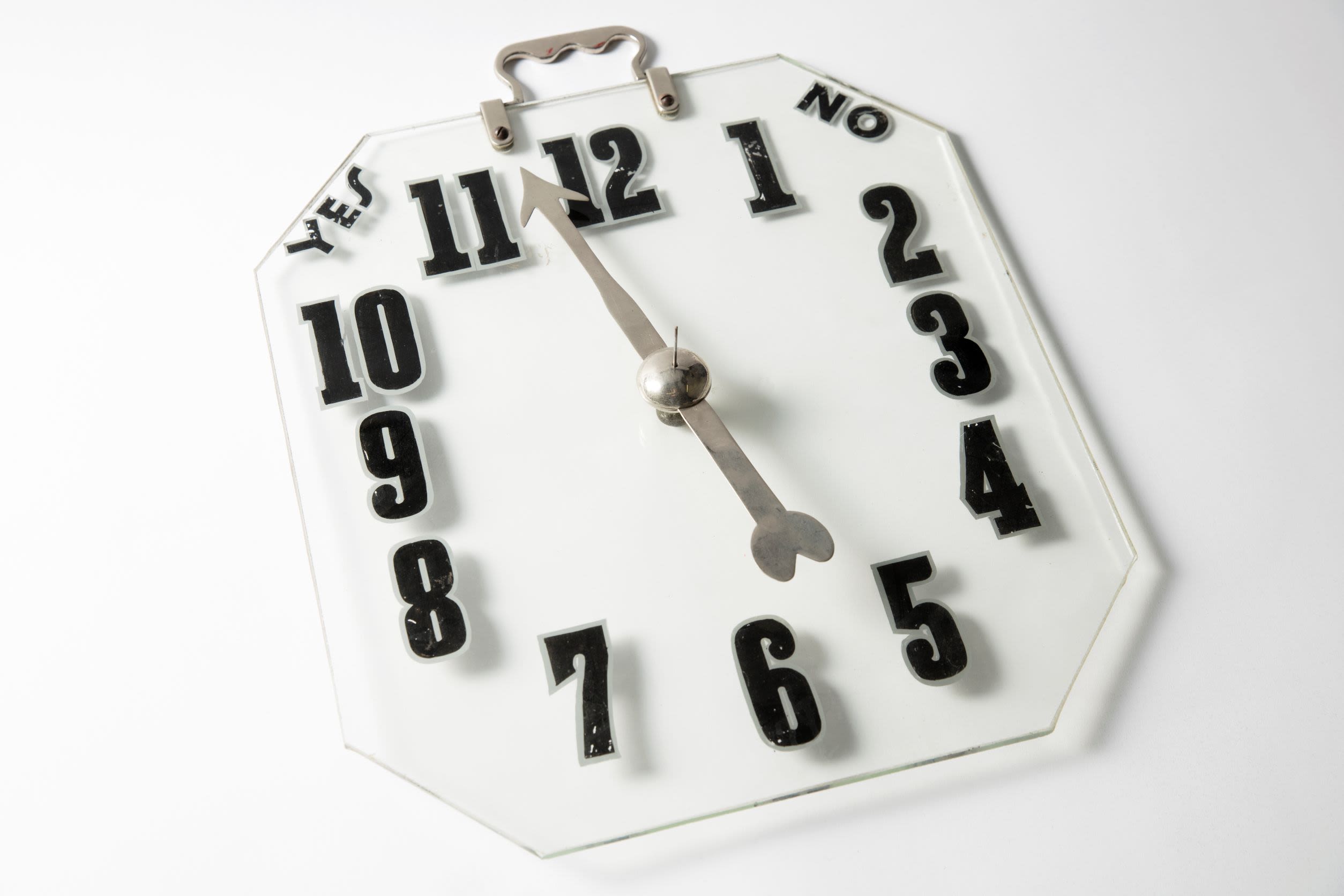
Clock illusion used by Myrtle Roberts, Australian Performing Arts Collection
Clock illusion used by Myrtle Roberts, Australian Performing Arts Collection
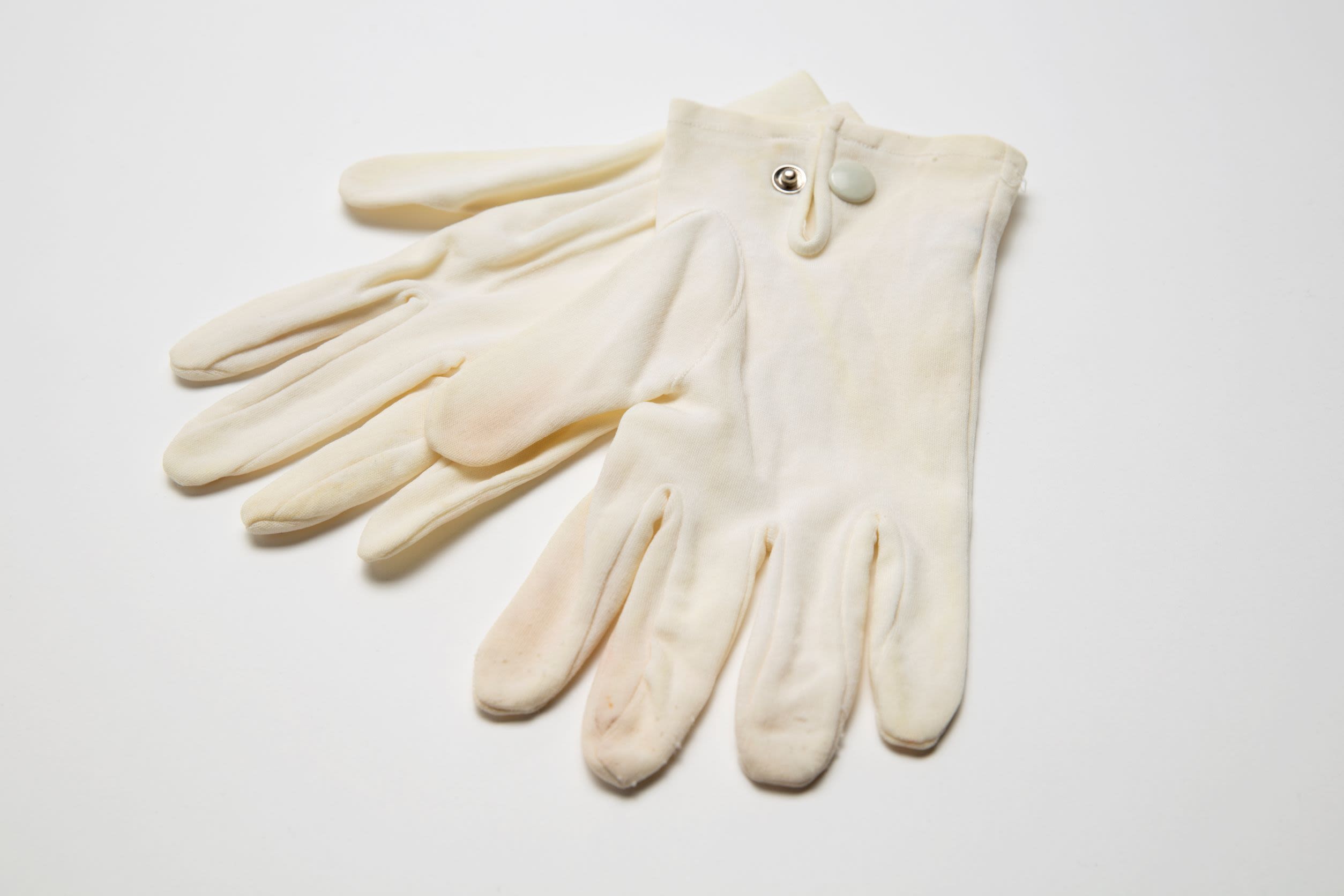
A pair of white gloves used by Myrtle Roberts, Australian Performing Arts Collection
A pair of white gloves used by Myrtle Roberts, Australian Performing Arts Collection
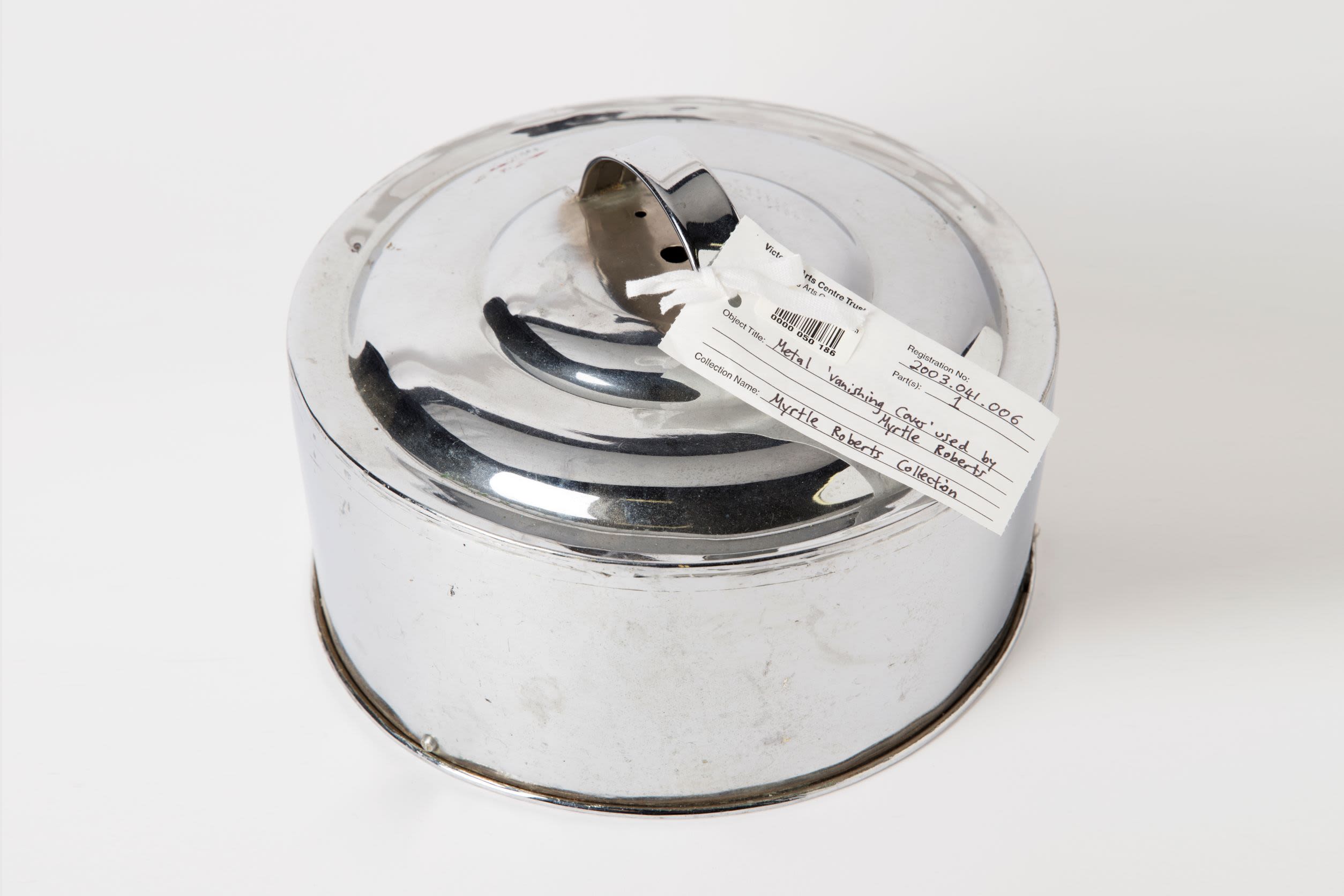
A metal vanishing cover used by Myrtle Roberts, Australian Performing Arts Collection
A metal vanishing cover used by Myrtle Roberts, Australian Performing Arts Collection
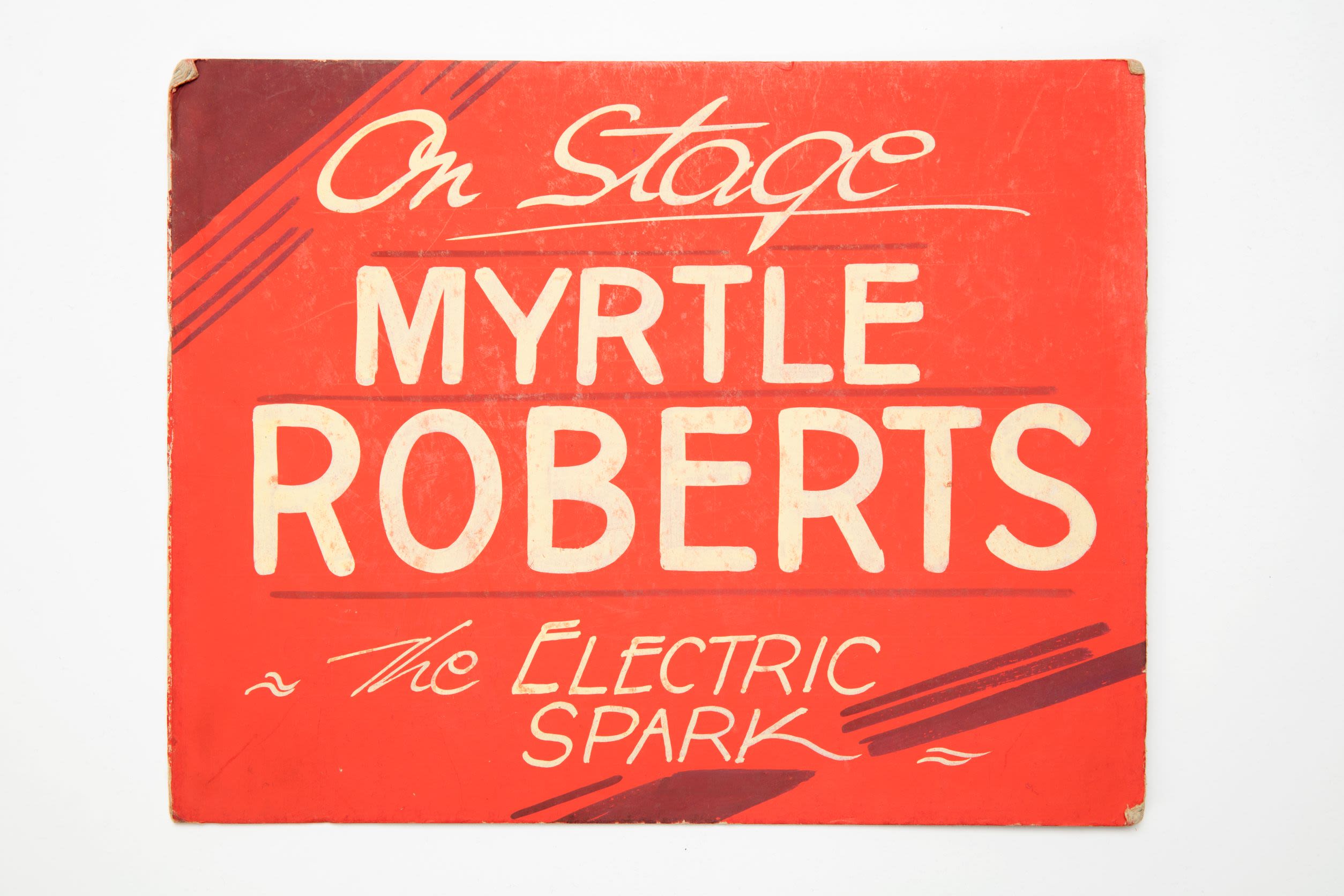
A hand painted sign for "Myrtle Roberts, the Electric Spark", Australian Performing Arts Collection
A hand painted sign for "Myrtle Roberts, the Electric Spark", Australian Performing Arts Collection
Myrtle's stage career began when she was hired to be a soubrette, and later a variety act, in suburban vaudeville halls around Melbourne. She would rehearse in the Temperance Hall on a Friday night and perform on a Saturday for 10 shillings a show.
By May 1934 she had obtained her first contract with the Tivoli as a showgirl and was paid five pounds a week.
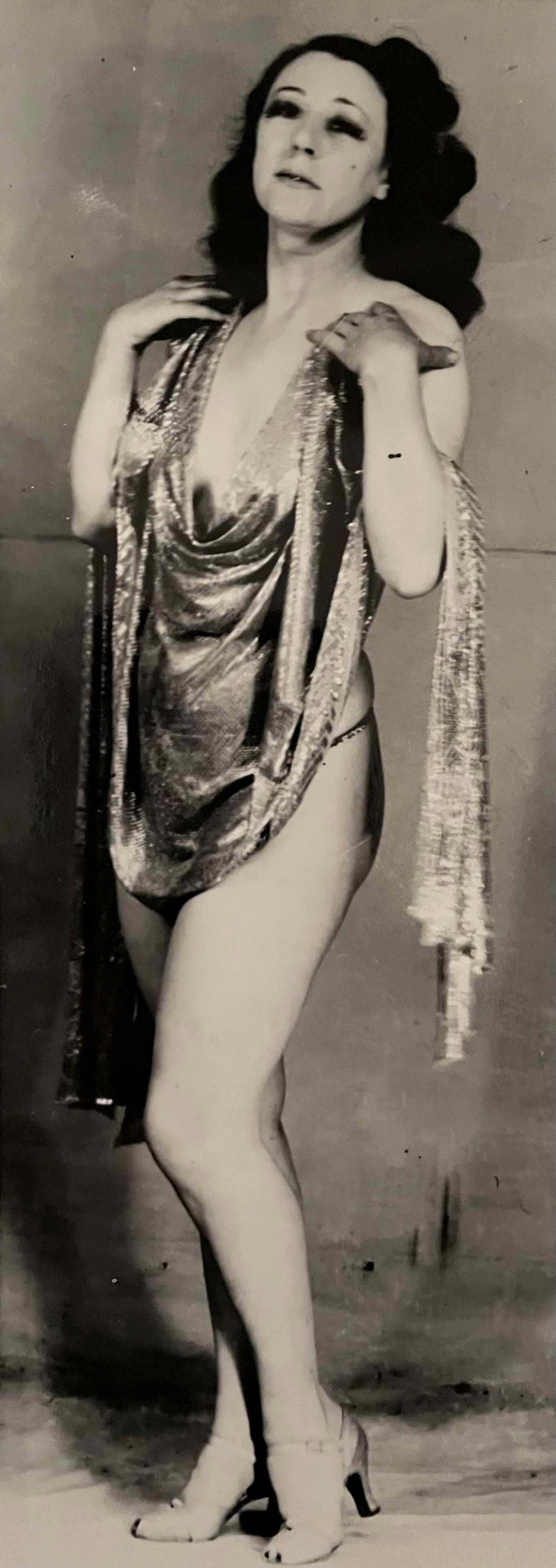
Myrtle Roberts in an undated photograph (courtesy of Pete Smith)
Myrtle Roberts in an undated photograph (courtesy of Pete Smith)
She would spend the next decades on the performing circuit with the Tivoli, Fullers vaudeville and Wirth's circus.
One of her more famous acts was at Luna Park in 1939 when, encased in a block of industrial ice moulded to fit her body, she emerged in a glamorous swimming costume and bathing cap. Although she said she never caught a cold, the bridge of her nose would ache from the smell of the ammonia used to create the ice.
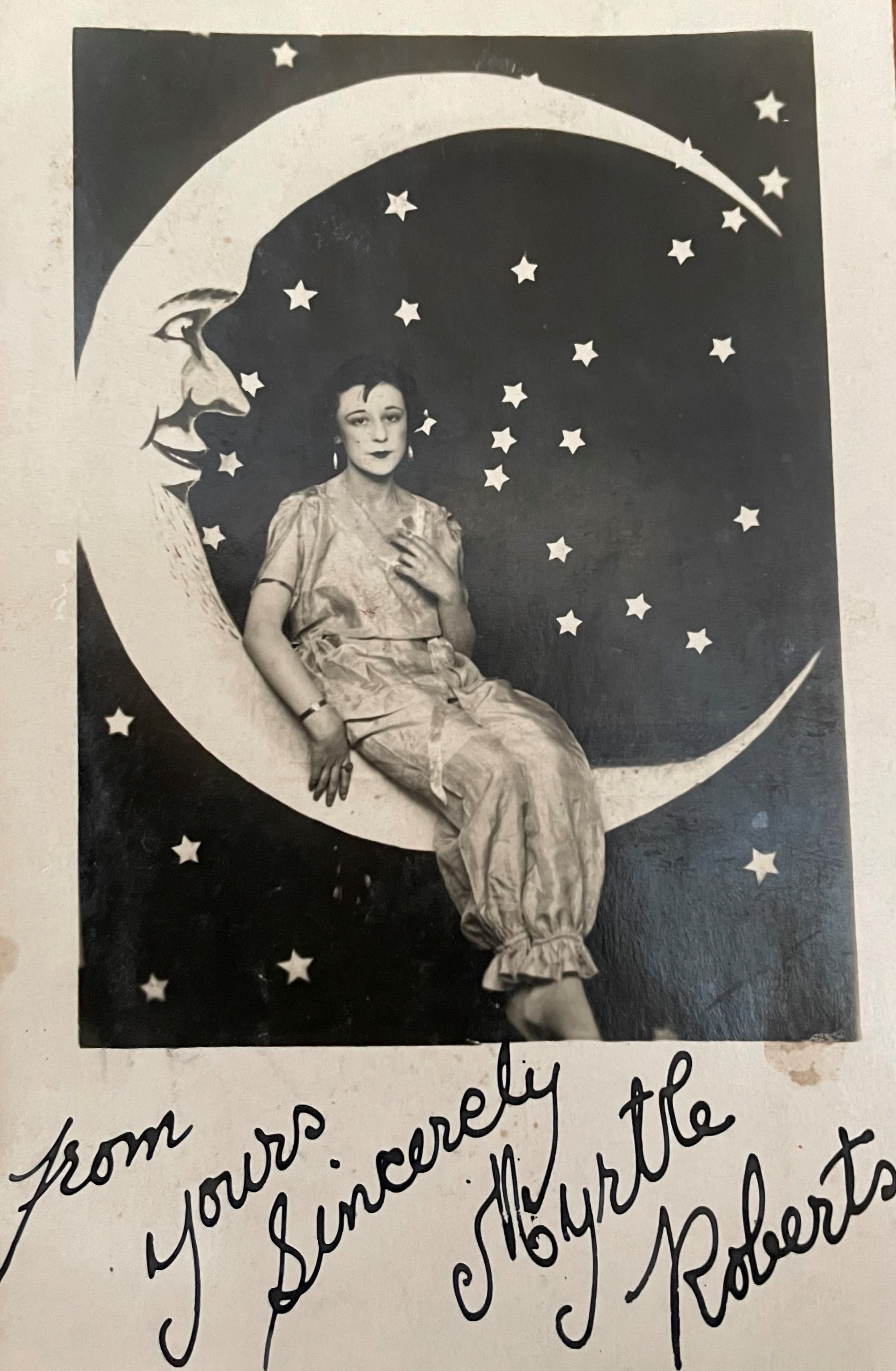
Myrtle Roberts, on the famous Moon seat at Luna Park, St Kilda, date unknown (courtesy of Pete Smith)
Myrtle Roberts, on the famous Moon seat at Luna Park, St Kilda, date unknown (courtesy of Pete Smith)
When not on the circuit, she took on roles as principal boy in pantomimes such as Babes in the Wood, Sinbad the Sailor and Puss in Boots. She honed her skills in "small magic" such as rope and cylinder tricks and releasing birds from a dish of fire.
"It was when we were doing Aladdin, as a matter of fact, that I first discovered my flair for magic," Myrtle later said. "The manager suggested a few tricks might liven up the cave scene, so I tried and it was a great success."
Her first billing was as Myrtle Roberts - comedienne, and then Myrtella-the electric spark - magician.
The latter was a fitting sobriquet. One of her closing acts was using a low current of DC electricity to make her tap shoes spark as she danced on a metal table.
"I never did manipulating or any of that sort of stuff but I had beautiful gear, all this showy gear and showy costumes and I think that is what helped me get through," she said in an interview with the ABC in 1979.
"If I bought a pair of pigeons they were the best. If I bought a bunny rabbit he was an Angora rabbit. If I had anything made it was always the best."
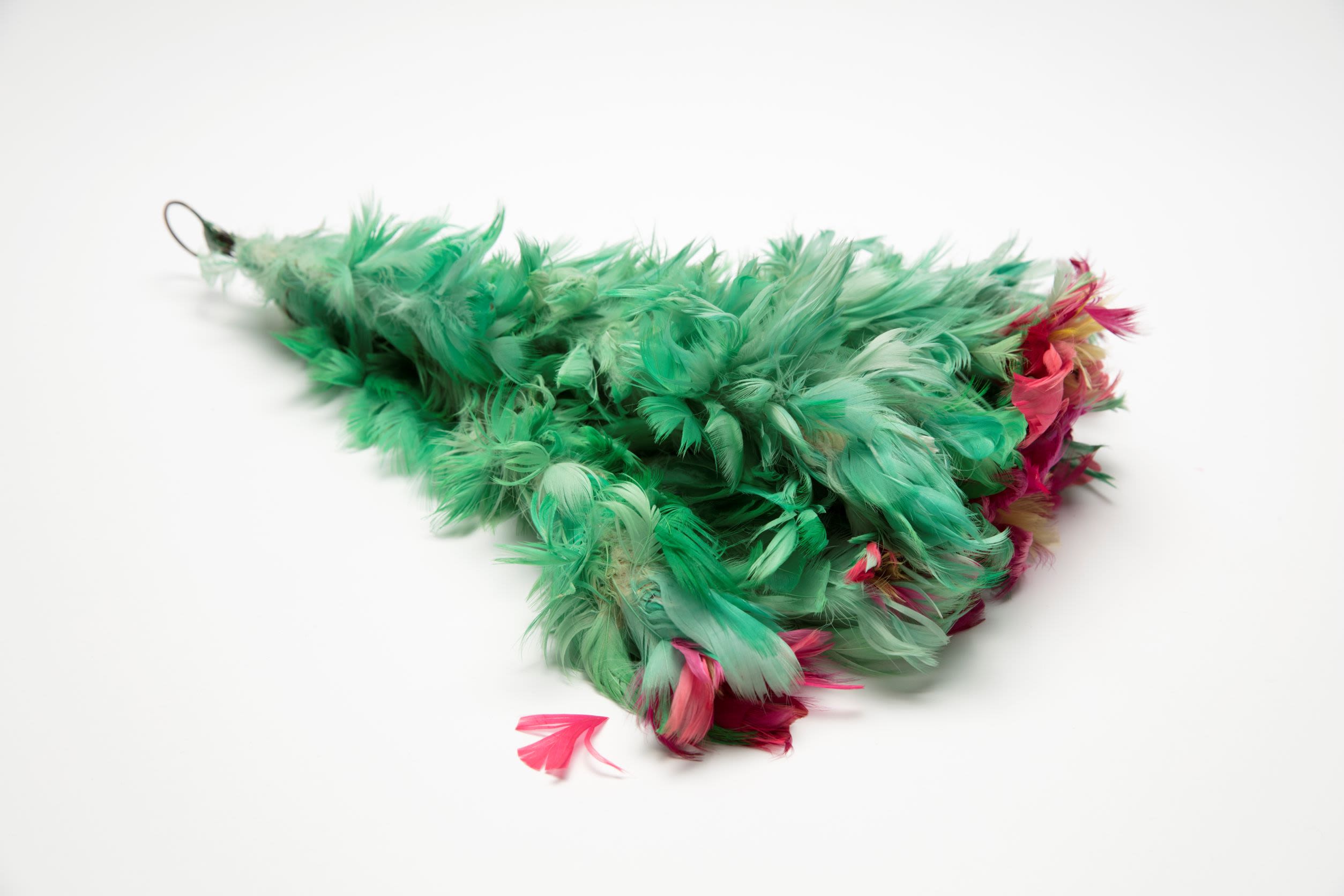
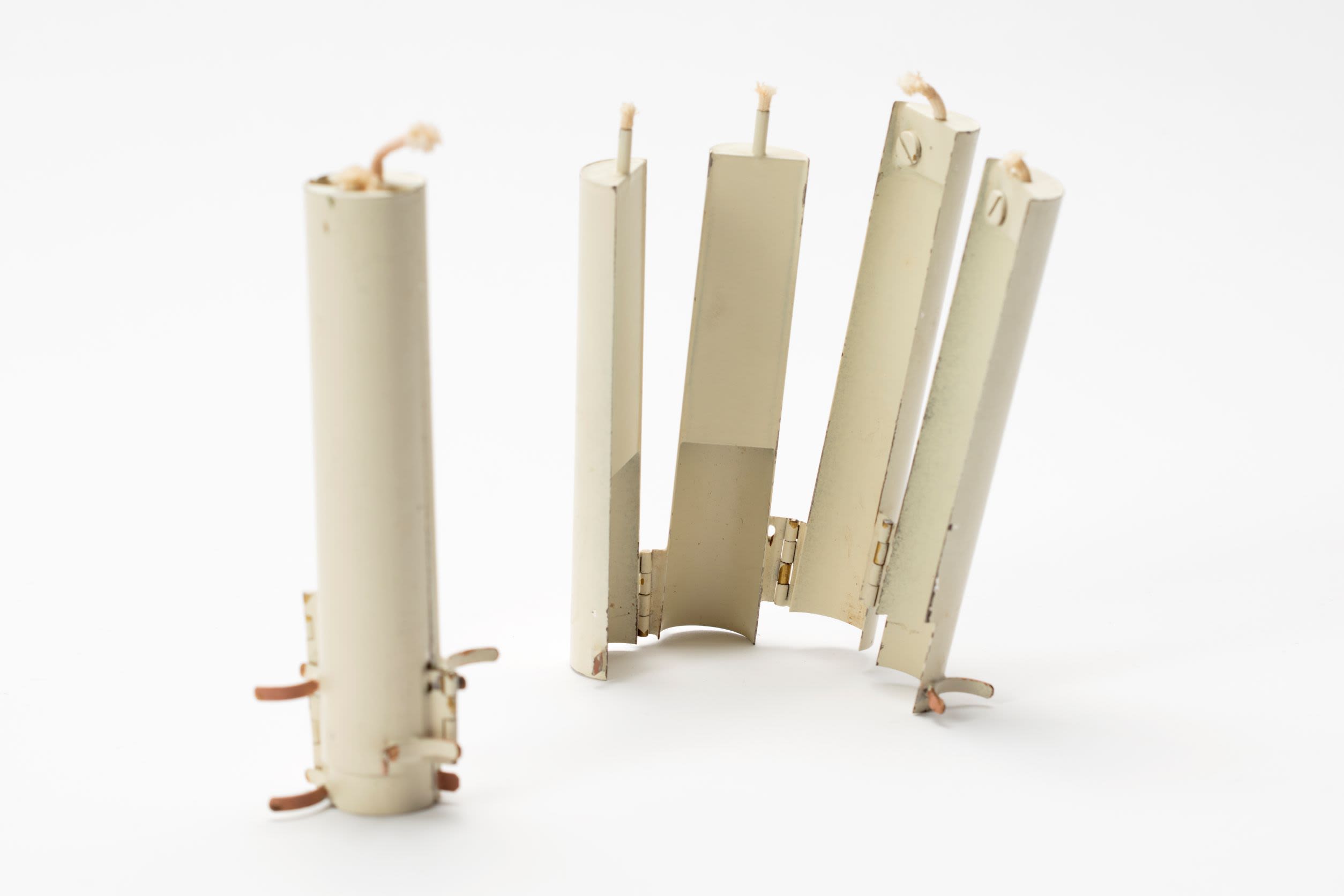
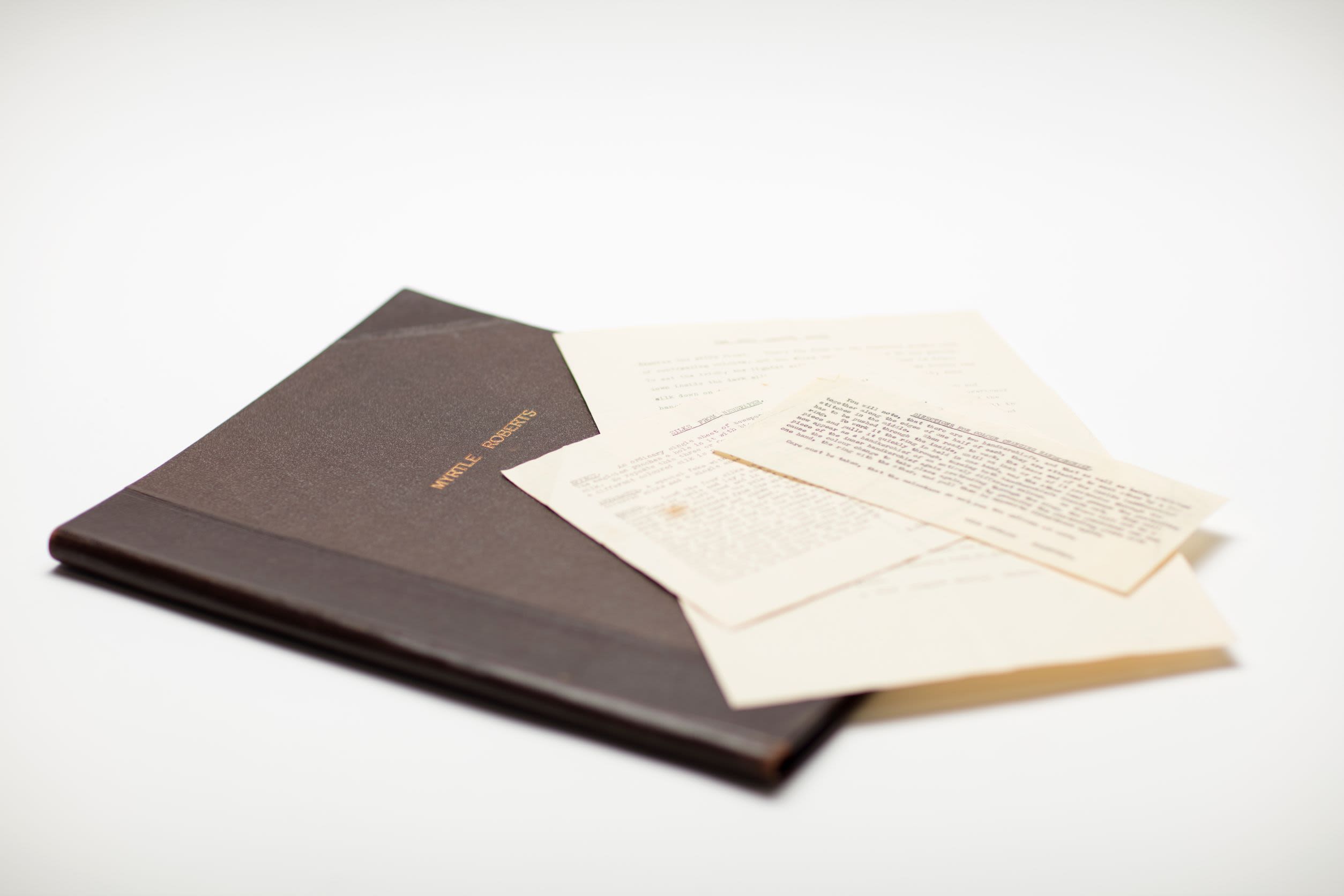

Magic flower apparatus used by Myrtle Roberts, Australian Performing Arts Collection
Magic flower apparatus used by Myrtle Roberts, Australian Performing Arts Collection

Multiplying candle apparatus used by Myrtle Roberts, Australian Performing Arts Collection
Multiplying candle apparatus used by Myrtle Roberts, Australian Performing Arts Collection

Folder and magic trick instructions used by Myrtle Roberts, Australian Performing Arts Collection
Folder and magic trick instructions used by Myrtle Roberts, Australian Performing Arts Collection
As well as magic performance, Myrtle's versatile career included singing in the long running Village Glee Club on ABC radio and performing as Lady Boxington in the 1960 JC Williamson production of My Fair Lady.
She would later declare in an interview with ABC radio that she was "never a star" and was content to be an "almost-ran".
"If you are a star you've got to stay up to be a star, or be out haven't you? But, you see, with me I have never been out of work and I just go on, and on, and on."
In a newspaper interview she told a reporter she had always wanted to be an actress but "producers would just take one look at me and ask me to take my clothes off".
"So I made the best of what I've got and became a vaudeville girl."
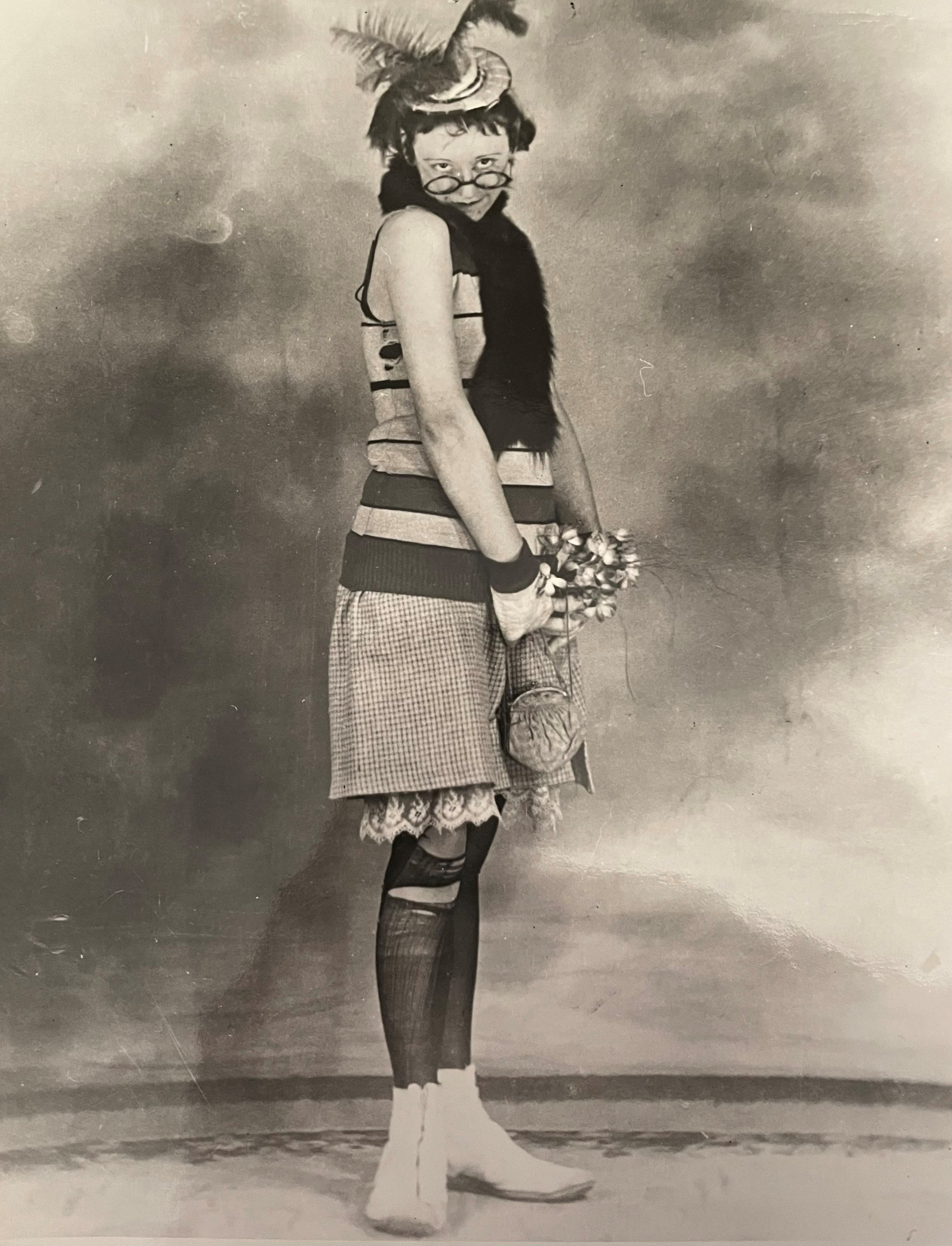
Myrtle Roberts in an undated photograph (courtesy of Pete Smith)
Myrtle Roberts in an undated photograph (courtesy of Pete Smith)
John Newman, who decades later would hire Myrtle as a performer in his Melbourne theatre restaurant, remembers seeing her perform as a teenager at the Tivoli. He was star struck.
"She used to come on stage with a huge white candle - it was about as high as your roof. She used to come out with... great big cane fishing rods that had white wings on them and she would come out and dance with very little clothing on.
"She had a beautiful figure, this was when she was 18 or 19, and she would flutter around and it was the moth around the flame.
"All of a sudden the flame would spurt up and she would pretend the wings had caught fire and she would lie down and cover herself with the wings."

Undated photograph of Myrtle Roberts performing, Australian Performing Arts Collection
Undated photograph of Myrtle Roberts performing, Australian Performing Arts Collection
In 1946 a reviewer praised Myrtle's talents in a show at the Palais Theatre, St Kilda:
“In her latest creation the golden butterfly, a spectacular dance, the silk wings of the butterfly are made from 50 yards of the finest Japanese golden silk.
“She is acknowledged to be the most versatile artist on the Australian stage. Who else can equal this array of ability - soubrette, comedienne, radio artist, drama, principal boy, pantomime, magician, and crack rifle shot?”
And that same year Mr H. Llewellyn, a past president of the Australian Society of Magicians, wrote to a Mr F. L. Smith to provide his personal critique of Myrtle’s performance at the Prahran Town Hall.
He stated he was “surprised that Miss Roberts had not had the publicity she deserved, with her versatility and ability” and that she had “good looks, form, and magical talent quite out of the ordinary”.
“You ask how does Miss Roberts compare with the lady magicians I have knowledge of?,” he wrote. “Well, how few there are in the world of entertainment.”
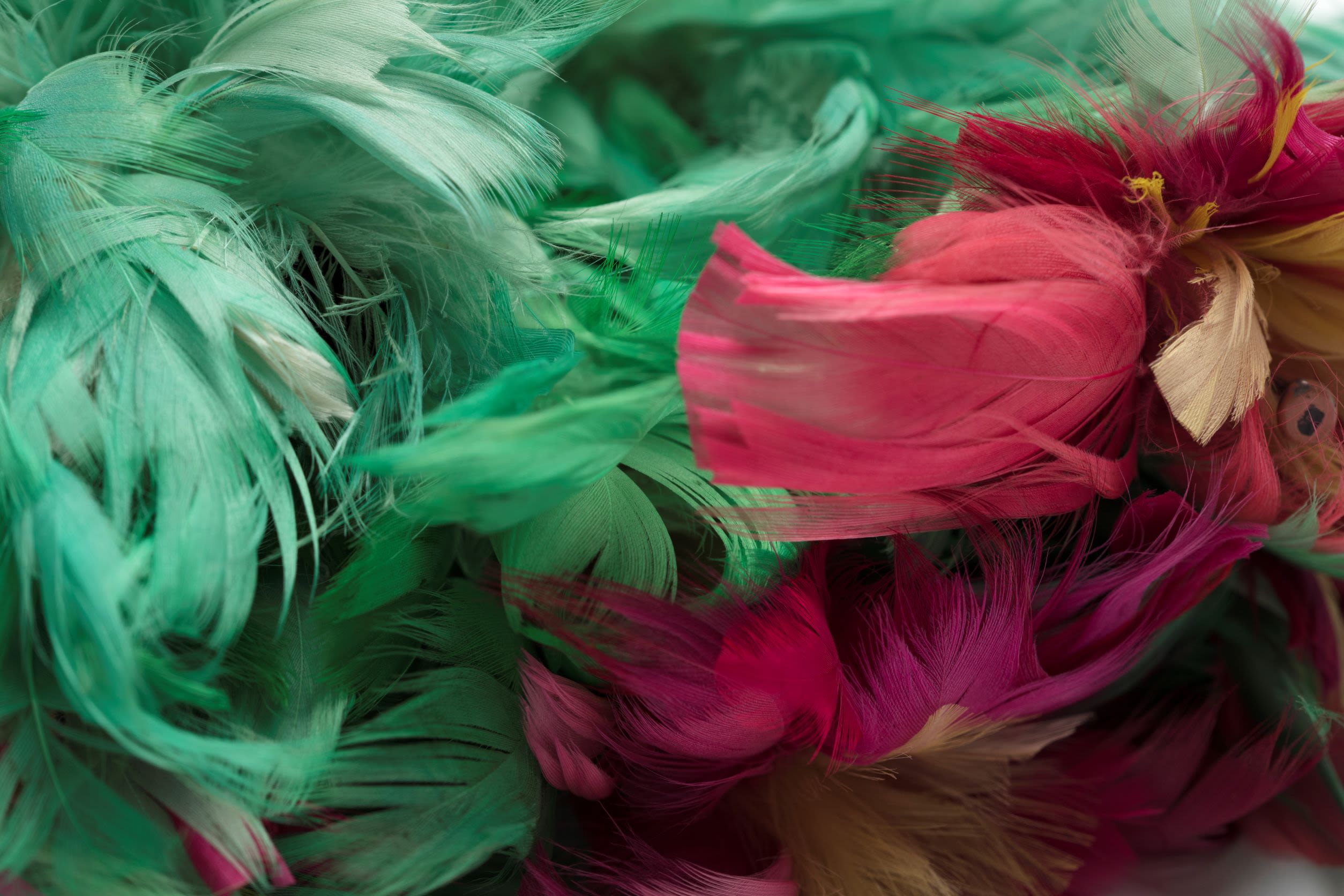
Moi-Yo Miller
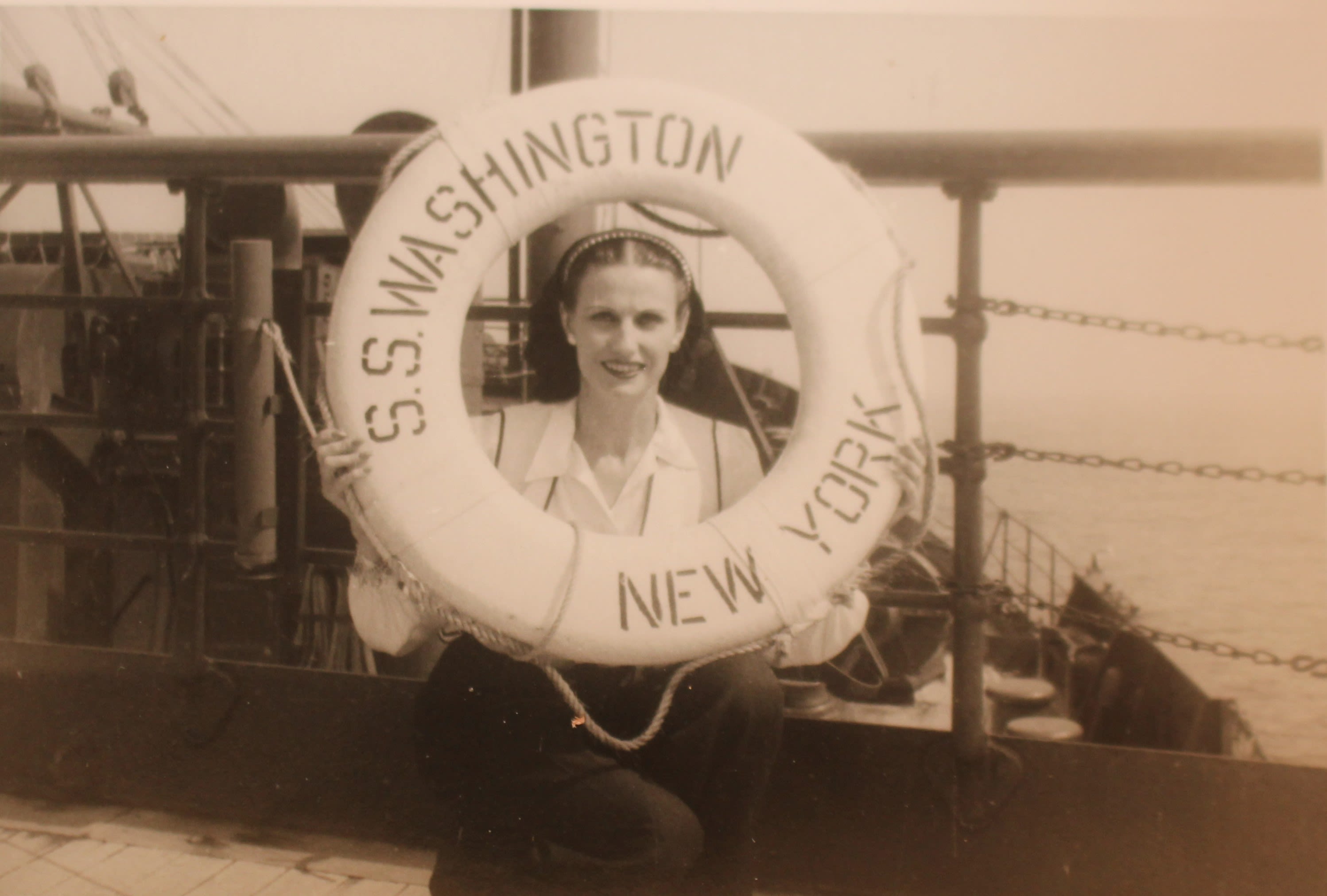
While it is true that it was rare for women to take top billing in magic shows of the time, to argue women did not play a significant role in the history of the art form is to overlook a central role - that of the female assistant.
Loretta Miller was working in an Ernest Rolls revue when in 1933 she signed on to be an assistant to one of America’s most famous magicians of the period, the Danish born Harry Jansen who worked under the stage name Dante.
Born Mona Loretta Miller in Geelong in November 1914, she was known simply as Loretta or by her nickname Mikki. She was on stage from the age of four, spending her childhood performing in ballet and Scottish dancing competitions with her sister throughout regional Victoria.
Her daughter Charisse Kininmonth, says her grandmother was immensely proud of her girls' talents and "touted them everywhere". After attending a ladies college in Geelong, a young Loretta became a dancer at the Princess Theatre in Melbourne, living for a time at the Hotel Windsor.
Around the time she signed on as Dante's assistant, she fell in love with Bill Jansen, Dante's son. When Bill was tragically killed in a motorcycle accident in Brisbane, she became not just an assistant but also one of the family.
Under her stage name Moi-Yo, she would go on tour with Dante throughout Asia, Russia, Europe and America in shows such as his renowned Sim-Sala-Bim. She would be his leading assistant for the next two decades.
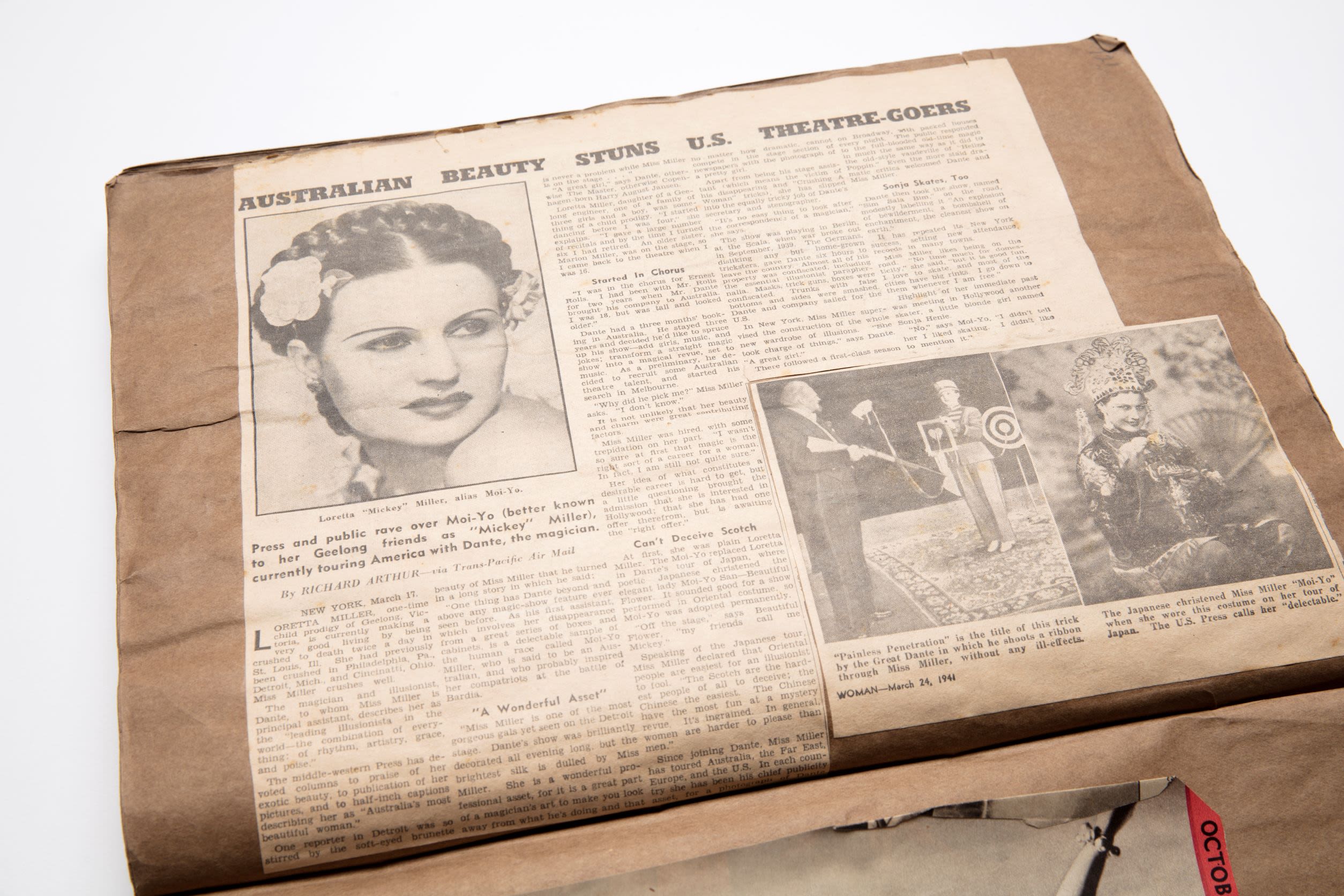
It was while on tour in Japan that she was reportedly christened “Moi-Yo San" which press of the day declared meant rare or beautiful flower. Kininmonth says her mother always believed it translated as beautiful butterfly, while other reports gave it Chinese origins.
Regardless of its true provenance, she enjoyed its exotic sound and Loretta would become Moi-Yo from now on. Publicity posters declared Moi-Yo was “Australia's most beautiful woman” and column inches were devoted to her appeal.
Although Moi-Yo was clear throughout her career that she was not a magician and was proud to call herself an assistant, there was no doubt she brought considerable design acumen to Dante’s show.
The show had a core of 35 performers and backstage staff and would collect additional team members in each country it visited. Staging such an elaborate performance was a herculean task.
Writing in 1993, Moi-Yo said “I trained all the female assistants. I also helped with the wardrobe, lighting and scenery. You name it, I did it”.
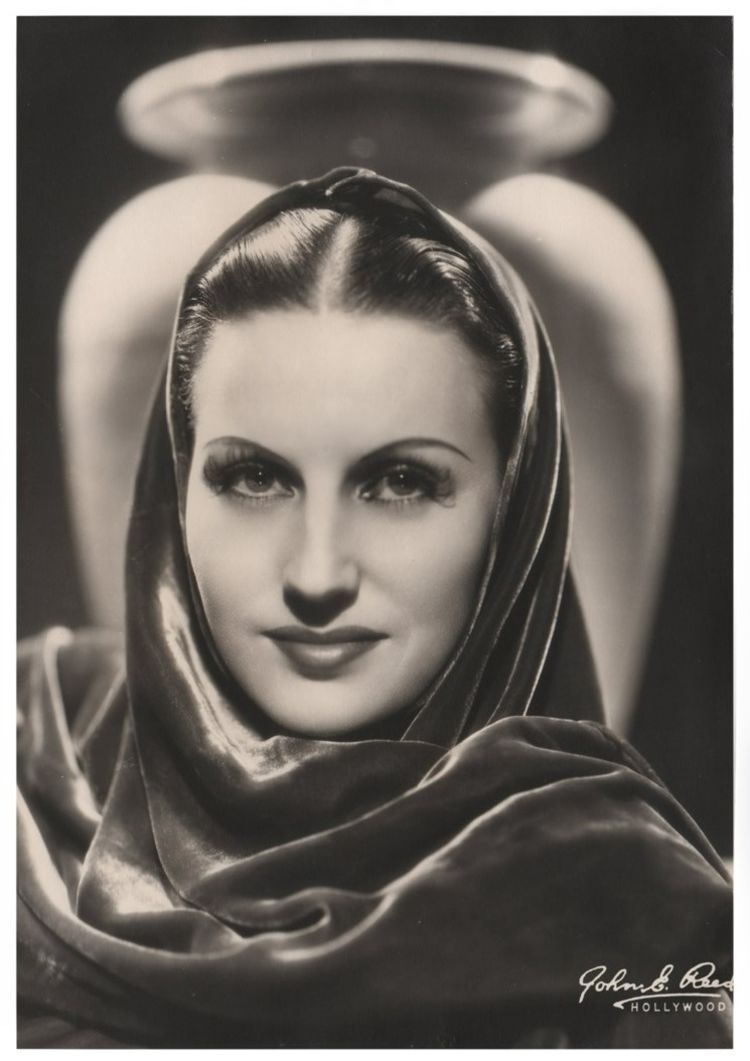
Moi-Yo Miller wearing her blue velvet dress, circa 1940s (courtesy of Charisse Kininmonth)
Moi-Yo Miller wearing her blue velvet dress, circa 1940s (courtesy of Charisse Kininmonth)
Dante's show would be transformed under Moi-Yo's tasteful eye. The showgirl costumes were replaced with elegant evening gowns and the circus style music retired in favour of more classical waltzes.
"She must have been well educated and well read," Kininmonth says of her mother.
"She had a knack of knowing how to incorporate the music with those costumes. I don't know where it came from but theatrically speaking she was amazing.
"She added so much more class to the whole program. It really became something completely different. Vaudeville left and it then became a show of illusions."
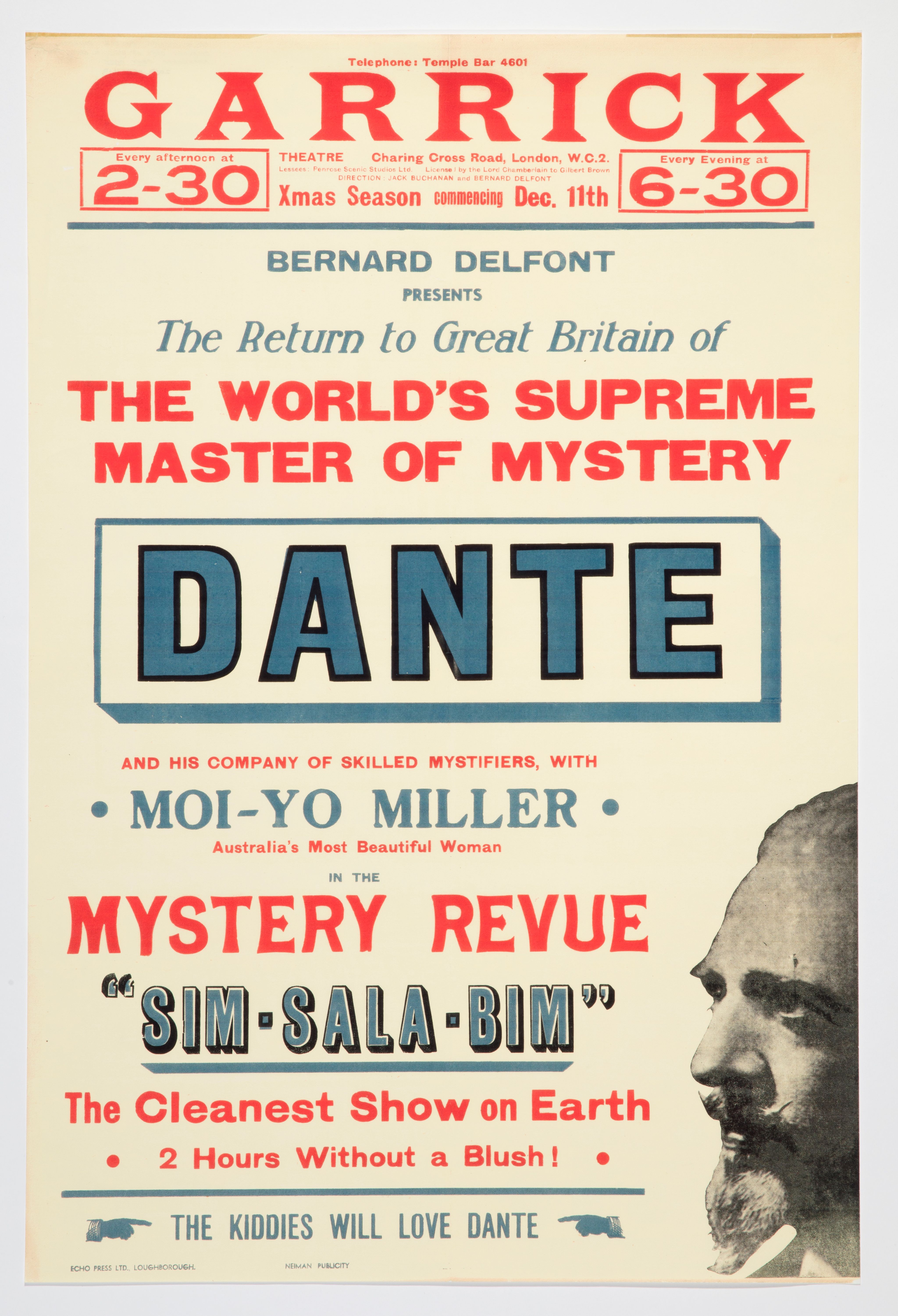
Poster for Dante's Mystery Revue "Sim-Sala-Bim" featuring Moi-Yo Miller, "Australia's most beautiful woman", Australian Performing Arts Collection
Poster for Dante's Mystery Revue "Sim-Sala-Bim" featuring Moi-Yo Miller, Australia's most beautiful woman, Australian Performing Arts Collection
Moi-Yo, who would later estimate she had been sawn in half 11,800 times during her career, told the ABC's Nostalgia Show in 1988 that her assistant role had not come without hazards.
"One particular thing I had to do was get into a trunk. The trunk had a canvas cover put around it and it was laced up. Then it was put onto a little platform and a canopy lowered over it.
"Well, when I started to get out of this trunk, after a few seconds Dante says 'One, two, three, and the lady is free', and I am yelling 'No, no I'm not'. The boys had put the trunk upside down and I could only get out one end.
"I struggled around and turned around and then I realised I couldn't get out that end anyway. And so I am in the throes of getting back to the proper end and the boys realised what they've done, opened the canopy and turned me up the other way, and gosh what a mess!
"I think it took me about 20 minutes to get out."
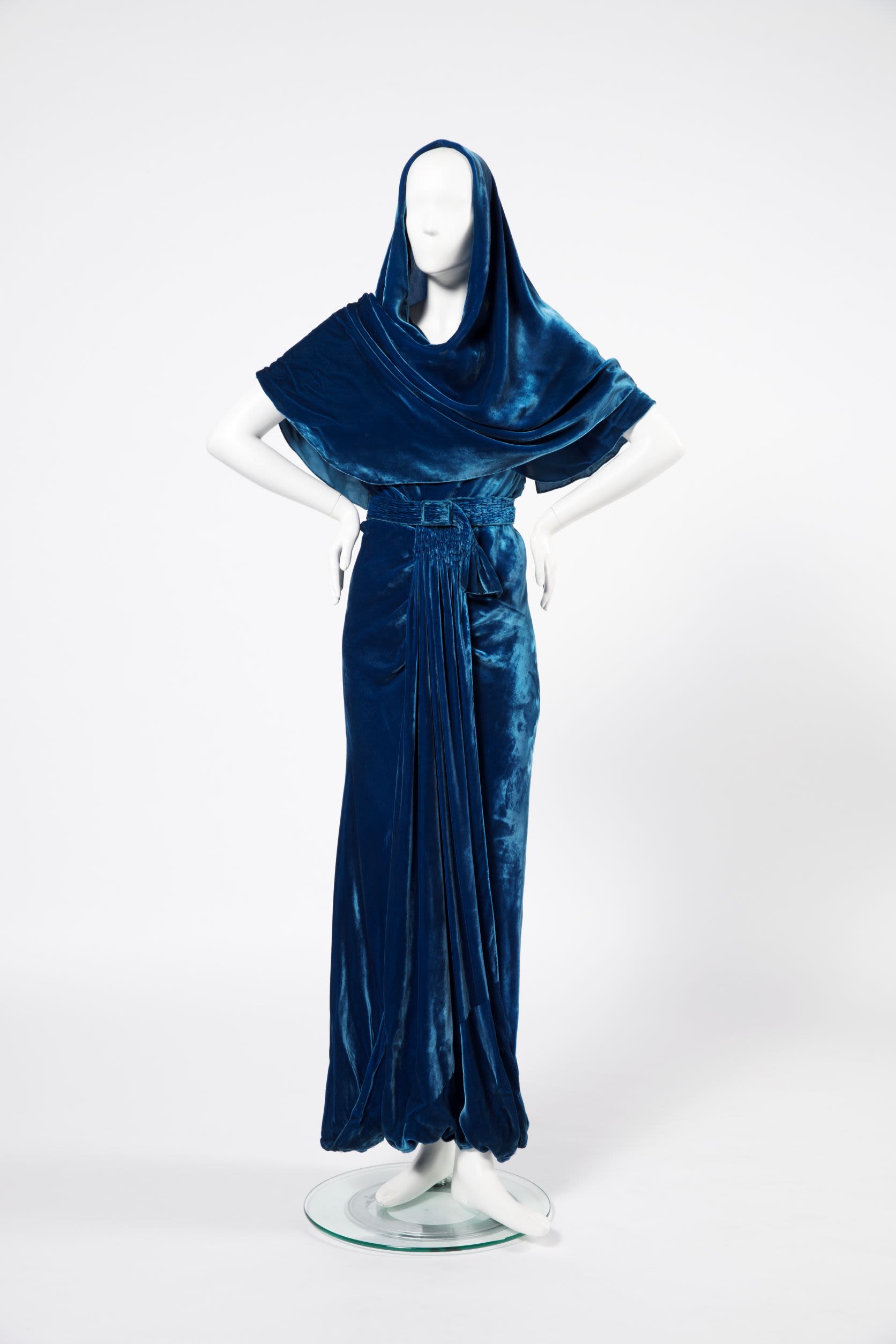
Dress worn by Moi-Yo Miller on tour with Dante, 1941-1945, Australian Performing Arts Collection
Dress worn by Moi-Yo Miller on tour with Dante, 1941-1945, Australian Performing Arts Collection
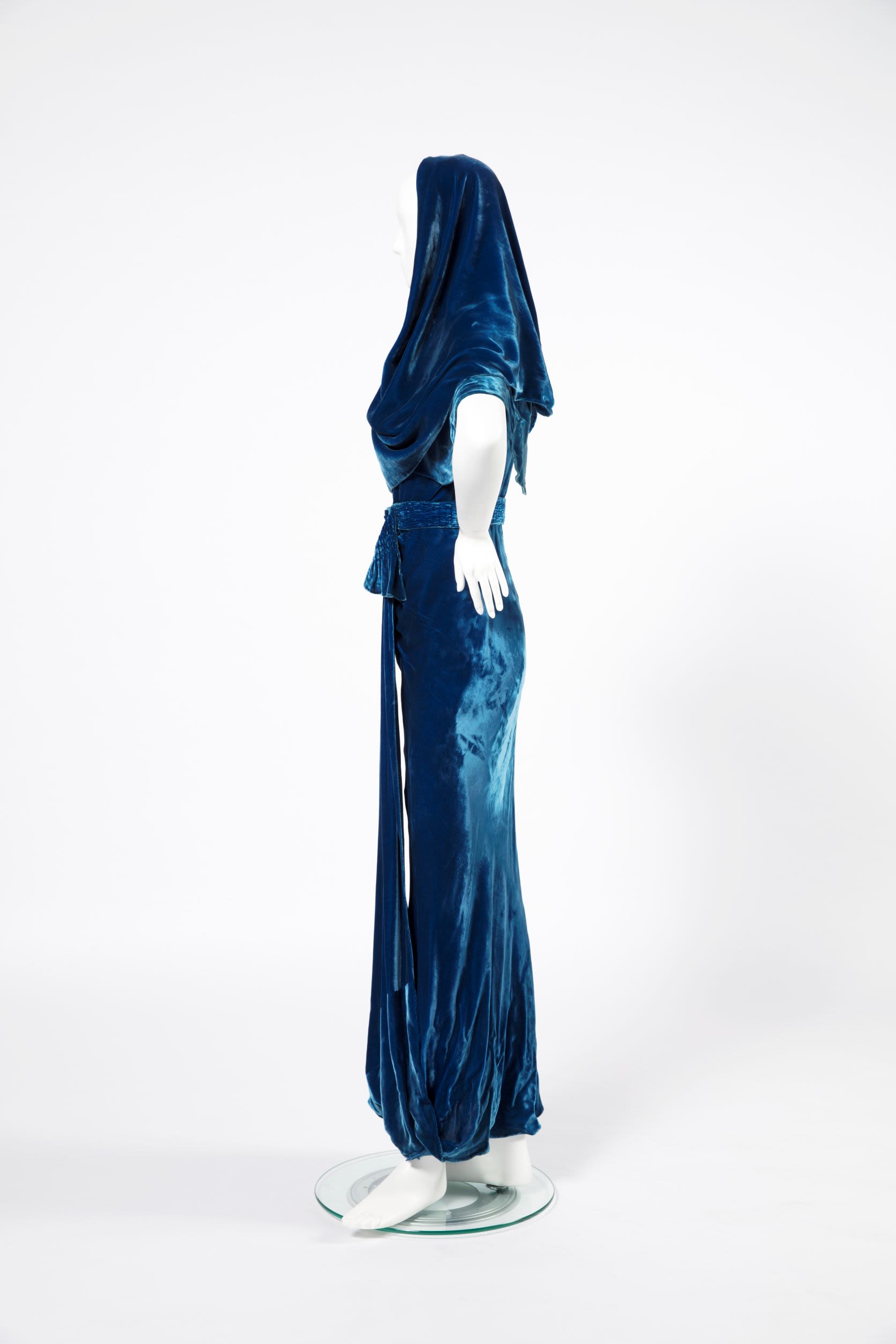
Dress worn by Moi-Yo Miller on tour with Dante, 1941-1945, Australian Performing Arts Collection
Dress worn by Moi-Yo Miller on tour with Dante, 1941-1945, Australian Performing Arts Collection
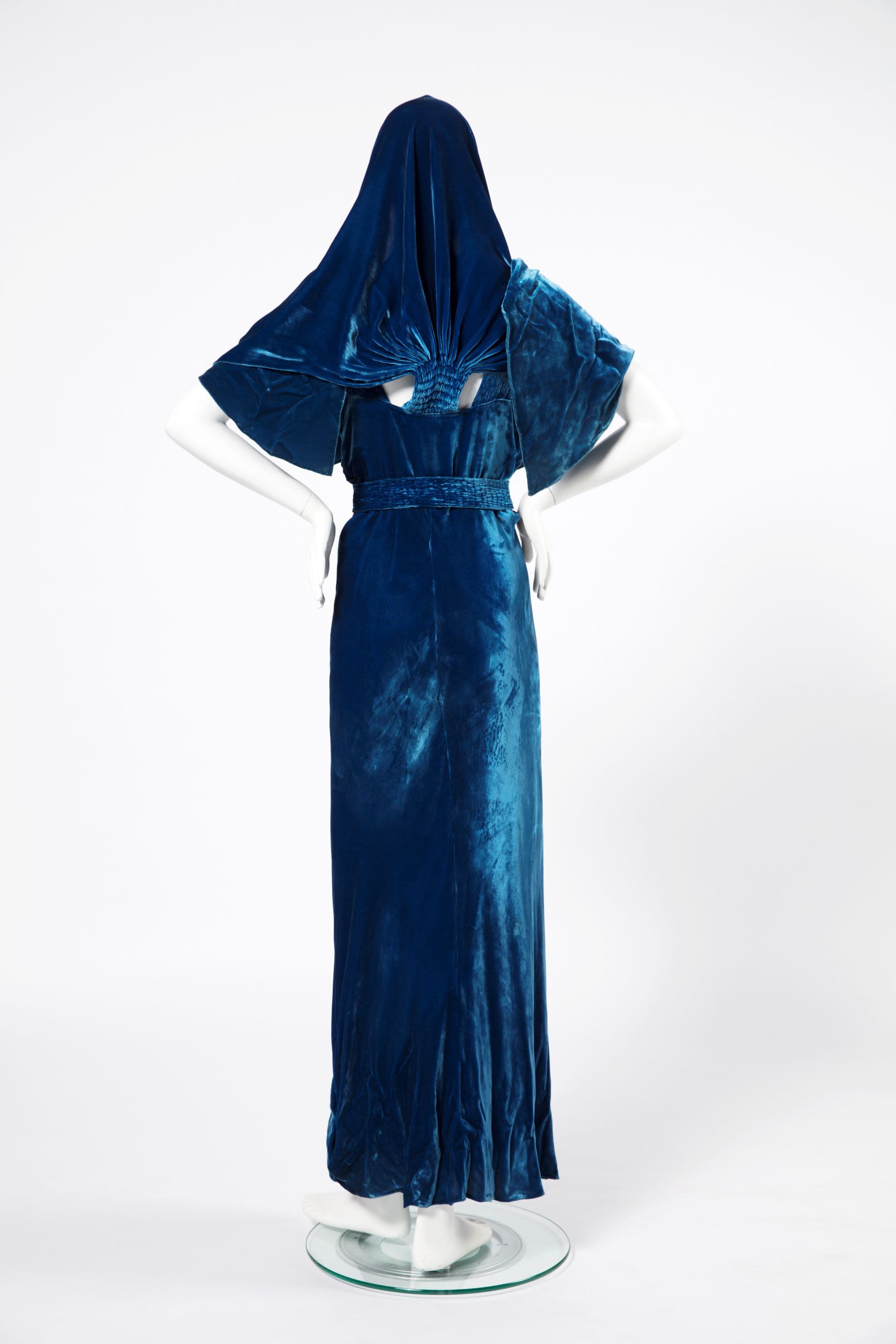
Dress worn by Moi-Yo Miller on tour with Dante, 1941-1945, Australian Performing Arts Collection
Dress worn by Moi-Yo Miller on tour with Dante, 1941-1945, Australian Performing Arts Collection
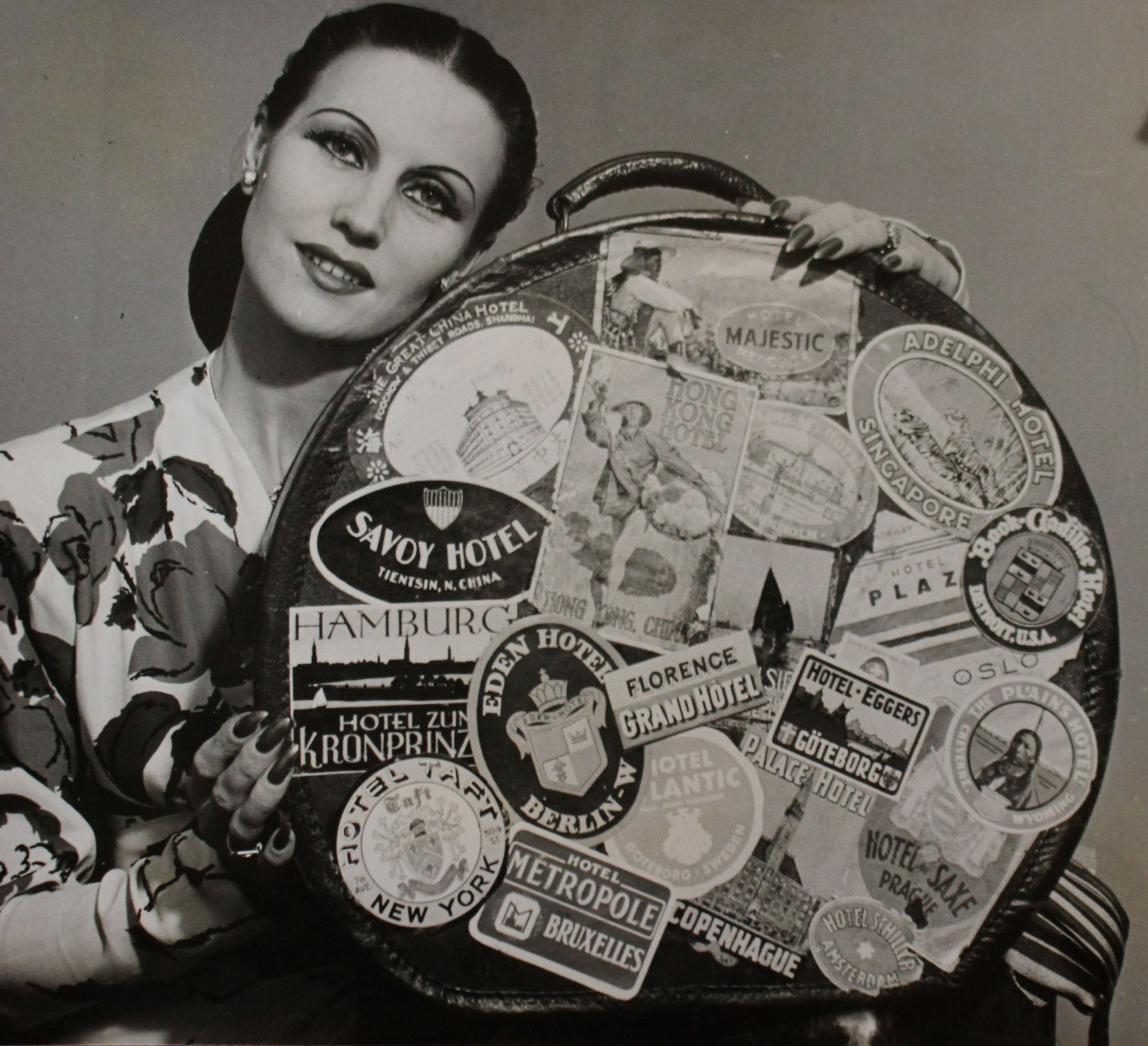
Moi-Yo Miller and her travelling hat box which is covered in the stickers of hotels she stayed in while on tour (courtesy of Charisse Kininmonth)
Moi-Yo Miller and her travelling hat box which is covered in the stickers of hotels she stayed in while on tour (courtesy of Charisse Kininmonth)
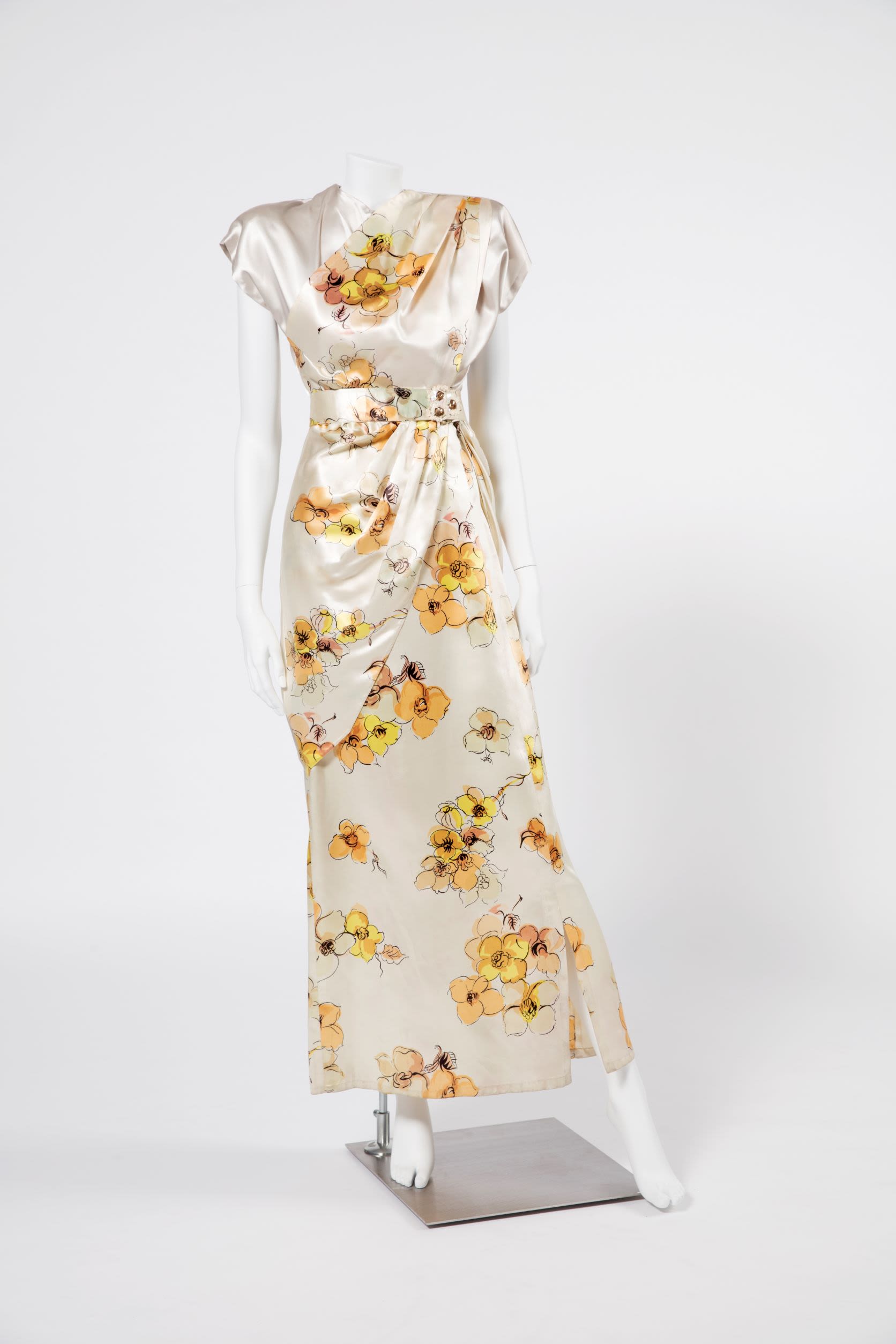
Dress worn by Moi-Yo Miller during Dante's 1946-1949 tour of Europe and the British Isles, Australian Performing Arts Collection
Dress worn by Moi-Yo Miller during Dante's 1946-1949 tour of Europe and the British Isles, Australian Performing Arts Collection
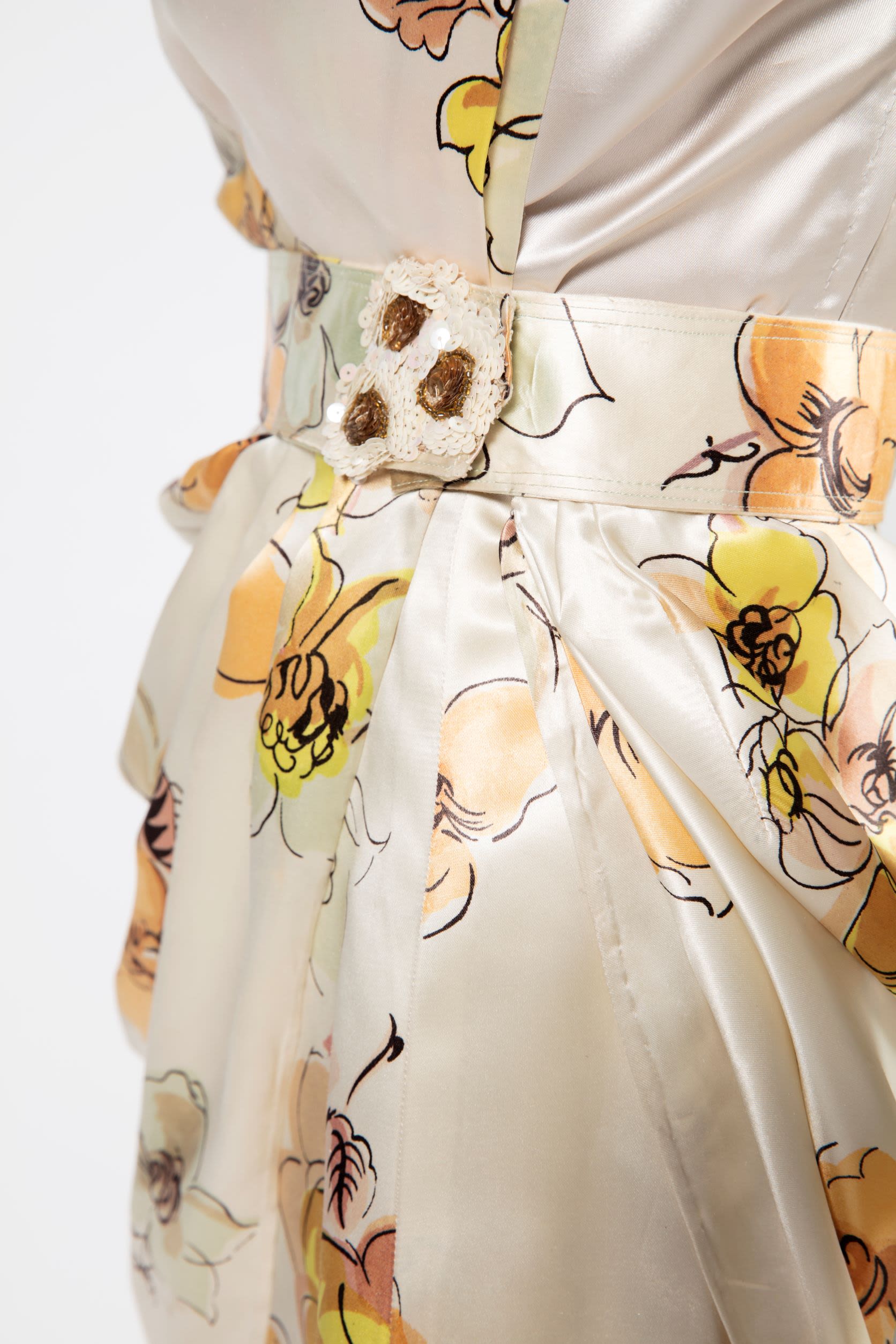
Detail of dress worn by Moi-Yo Miller during Dante's 1946-1949 tour of Europe and the British Isles, Australian Performing Arts Collection
Detail of dress worn by Moi-Yo Miller during Dante's 1946-1949 tour of Europe and the British Isles, Australian Performing Arts Collection
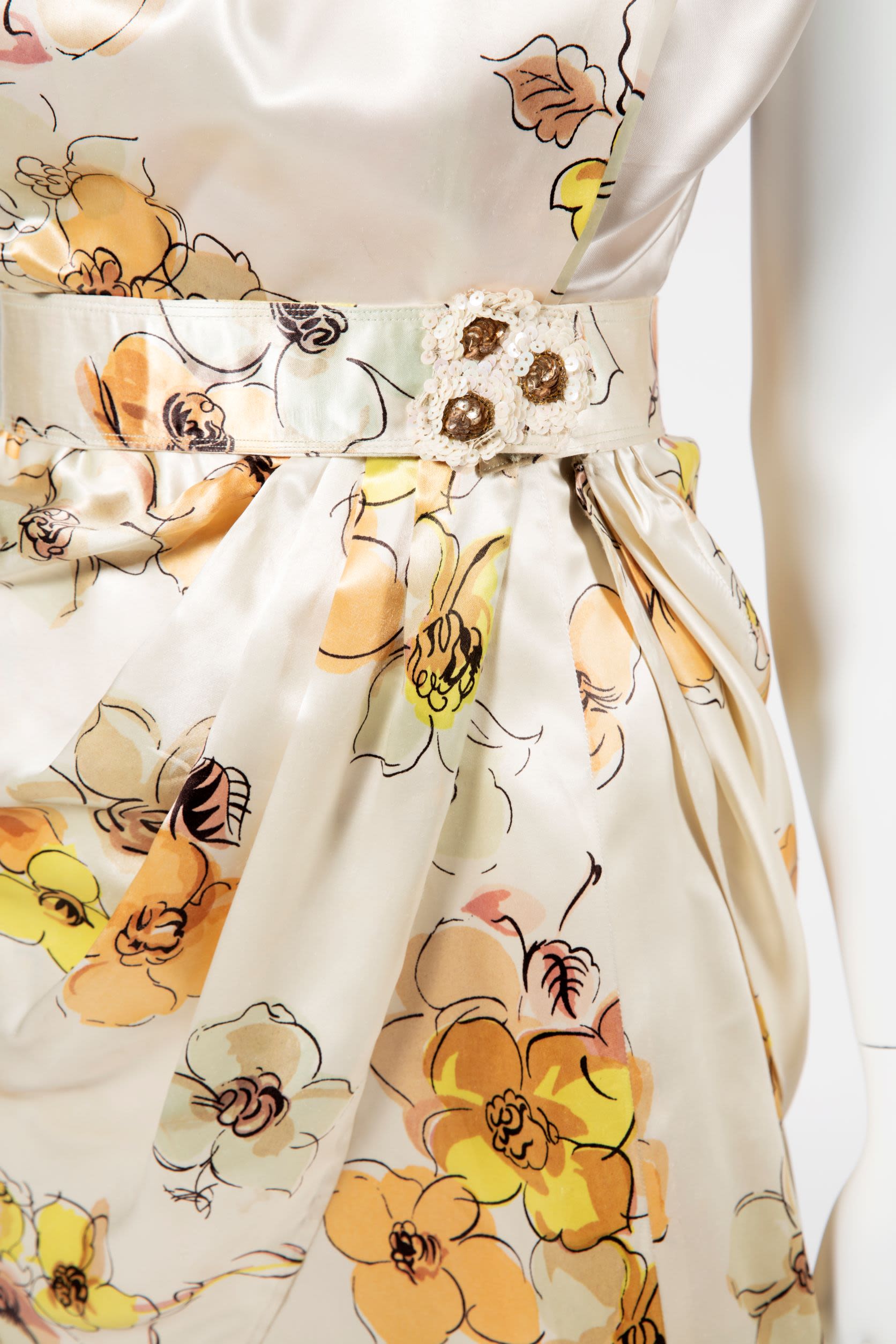
Detail of dress worn by Moi-Yo Miller during Dante's 1946-1949 tour of Europe and the British Isles, Australian Performing Arts Collection
Detail of dress worn by Moi-Yo Miller during Dante's 1946-1949 tour of Europe and the British Isles, Australian Performing Arts Collection
Keeping up with new tricks and illusions was undoubtedly a taxing job with rehearsals occurring every day.
"Every morning there would be a call for the fellows to come in and take care of all the props and see that they were all in good running condition - however, not too good running condition.
"One smart Alec we had, had oiled everything one day. I came in to do this illusion, and I knew just the pressure to put on this particular bit of apparatus, and he had oiled it. I nearly cut my fingers off."
Being on tour also brought its own challenges, with the troupe surviving a typhoon in Japan which ripped the side off their accommodation. When war broke out they received just six hours notice to pack up and get out of Hitler's Berlin. According to Kininmonth, the troupe was tipped off that borders were about to close by a member of the SS who had taken a shine to her mother.
Dante's company fled to Sweden and Moi-Yo would later recall that "we left there [Berlin] with most of the show sitting on the [rail] siding and most of that we didn't get back again. It had to be rebuilt."
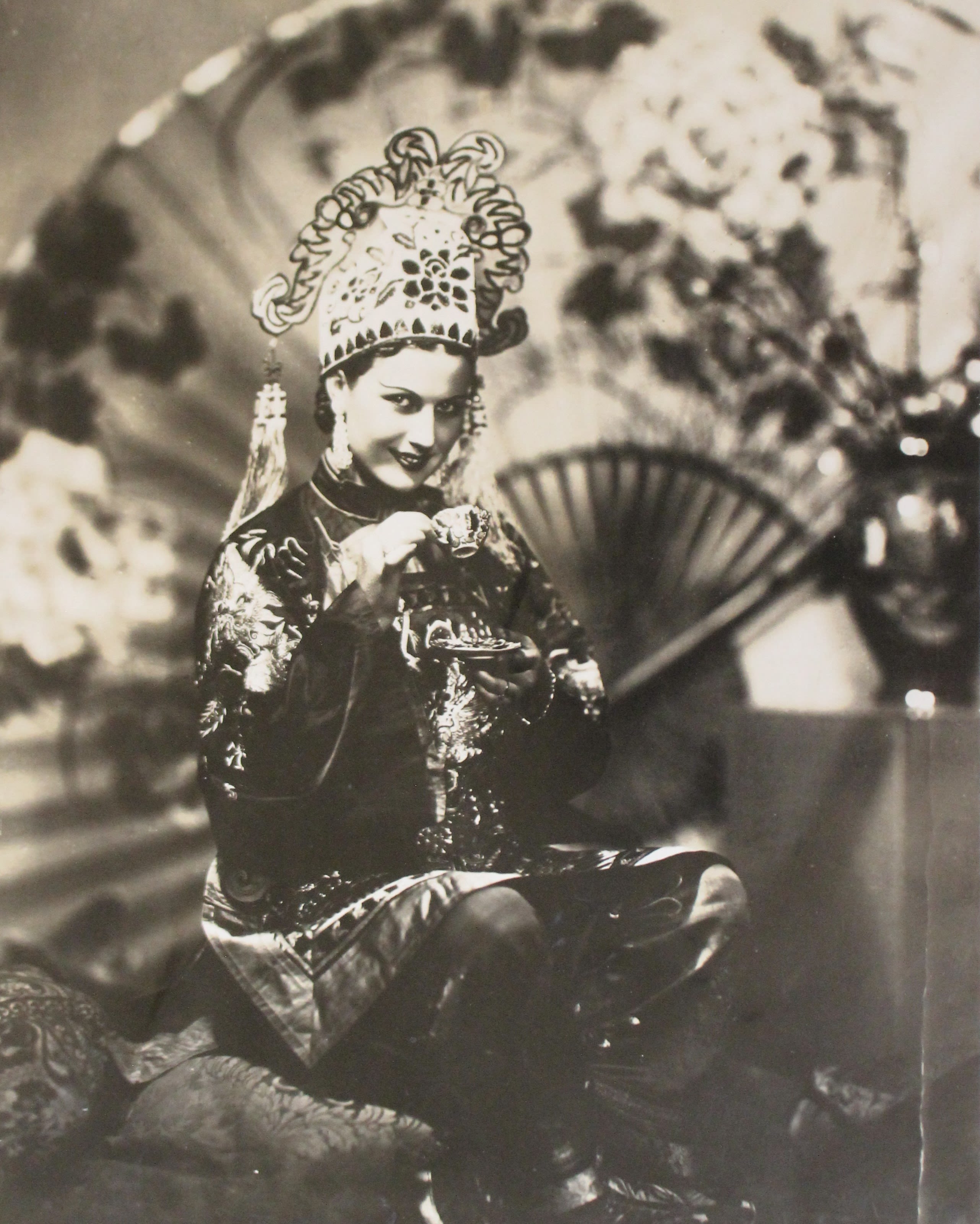
Moi-Yo Miller in "Oriental" costume (photo courtesy of Charisse Kininmonth)
Moi-Yo Miller in "Oriental" costume (photo courtesy of Charisse Kininmonth)
Moi-Yo said "it was a wonderful, magical tour, touring with Dante. Shanghai to Berlin to London, all over".
"It was awe inspiring to say the least. Every day was a special event and every day was an adventure."
And Dante, to his credit, was quick to recognise Moi-Yo's importance to his show.
In an article in Woman, March 24, 1941 under the headline “Australian beauty stuns US theatre goers”, Dante described his leading assistant as the “leading illusionista in the world - the combination of everything: of rhythm, artistry, grace and poise”.
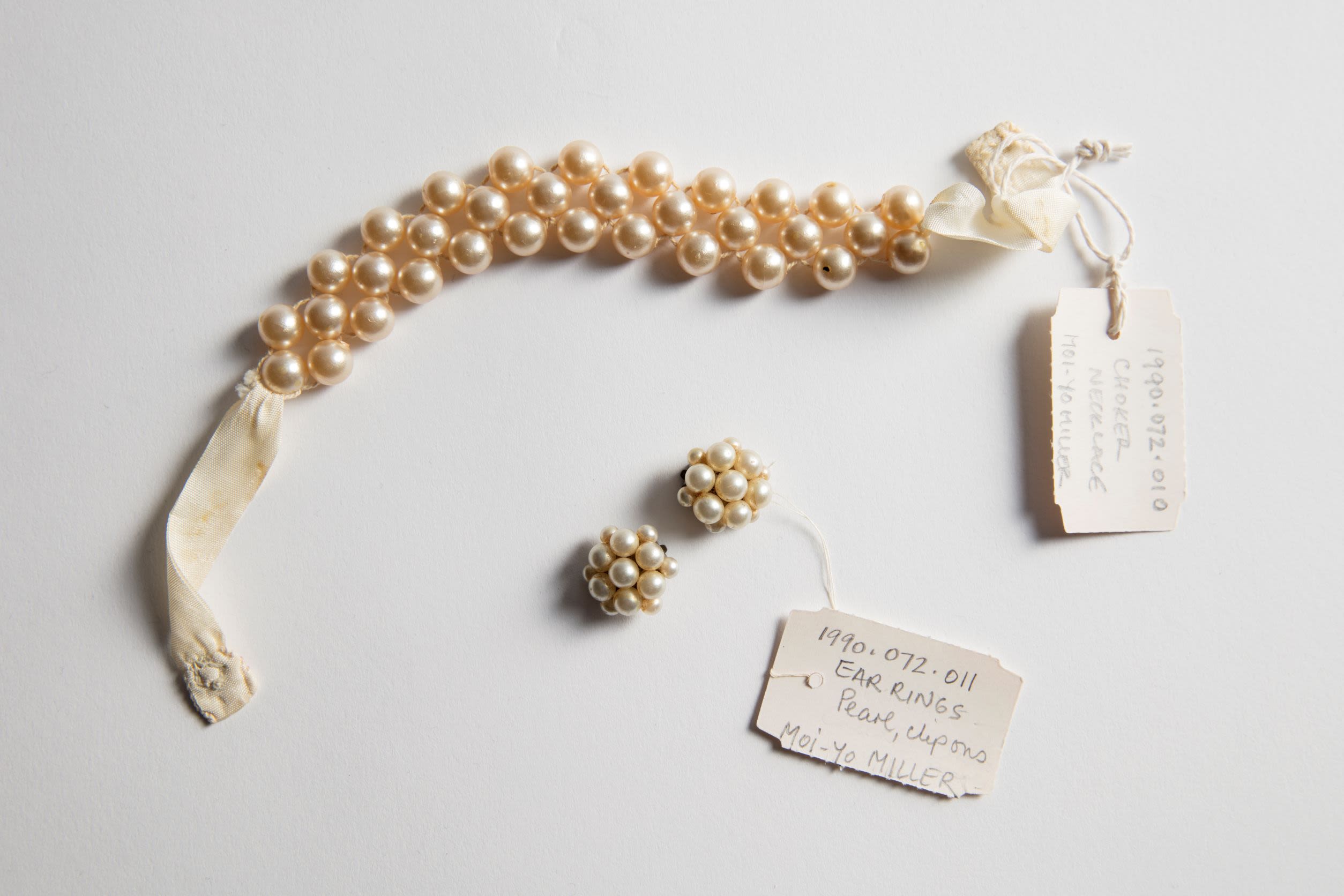
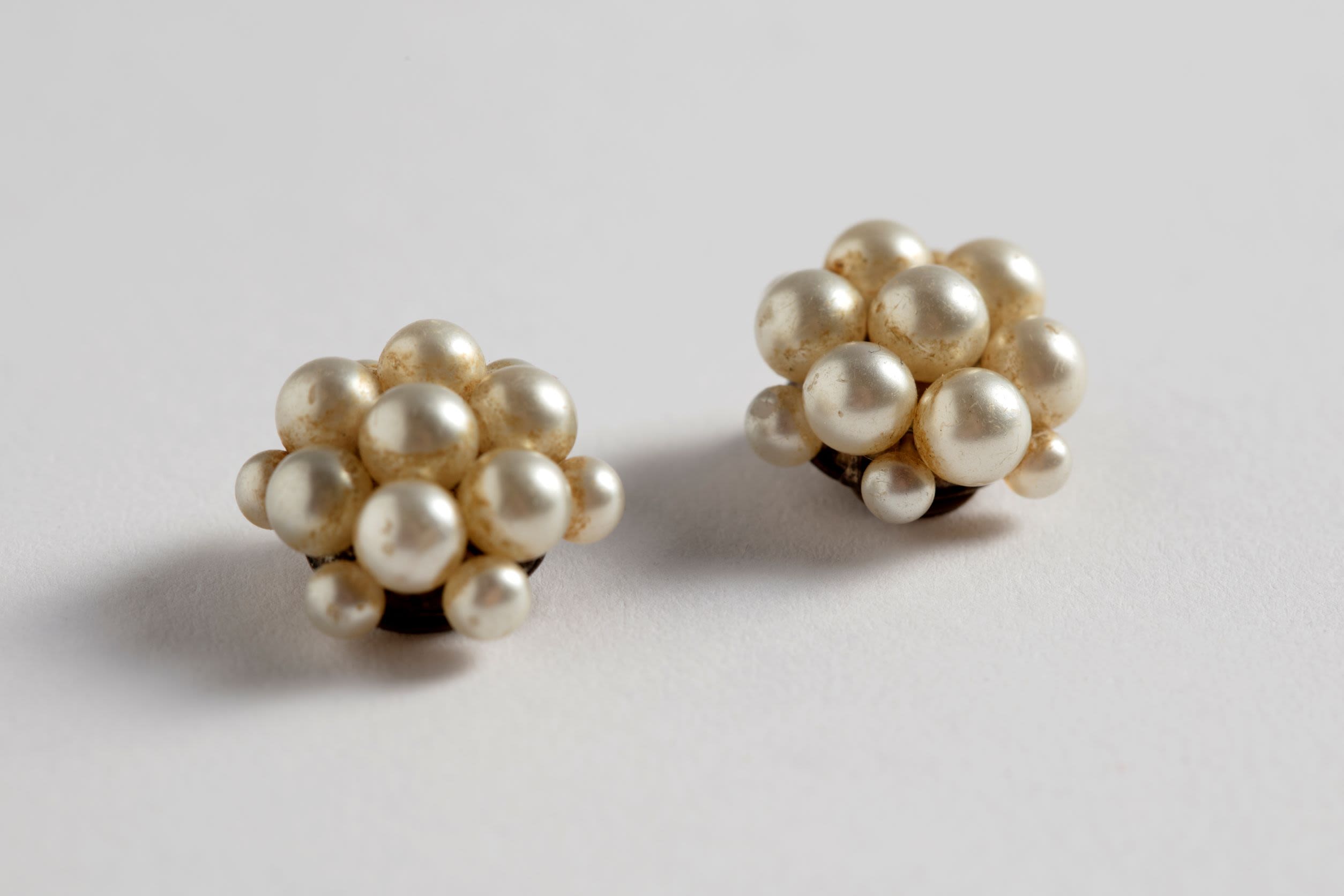
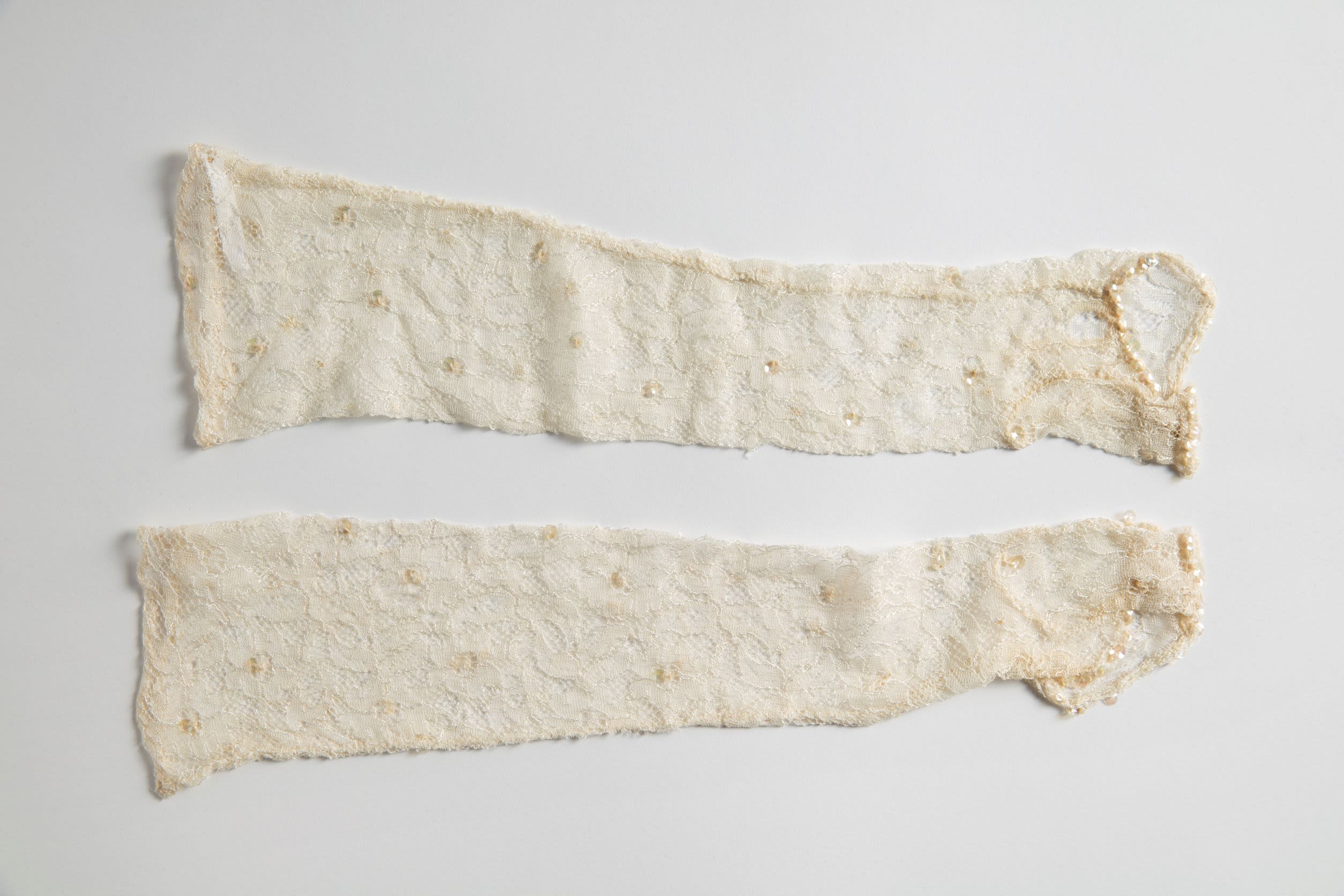

Choker necklace and earrings worn by Moi-Yo Miller, circa 1935, Australian Performing Arts Collection
Choker necklace and earrings worn by Moi-Yo Miller, circa 1935, Australian Performing Arts Collection

Earrings worn on stage by Moi-Yo Miller, circa 1935, Australian Performing Arts Collection
Earrings worn on stage by Moi-Yo Miller, circa 1935, Australian Performing Arts Collection

Gloves worn by Moi-Yo Miller while on tour with Dante, Australian Performing Arts Collection
Gloves worn by Moi-Yo Miller while on tour with Dante, Australian Performing Arts Collection
The curtain falls
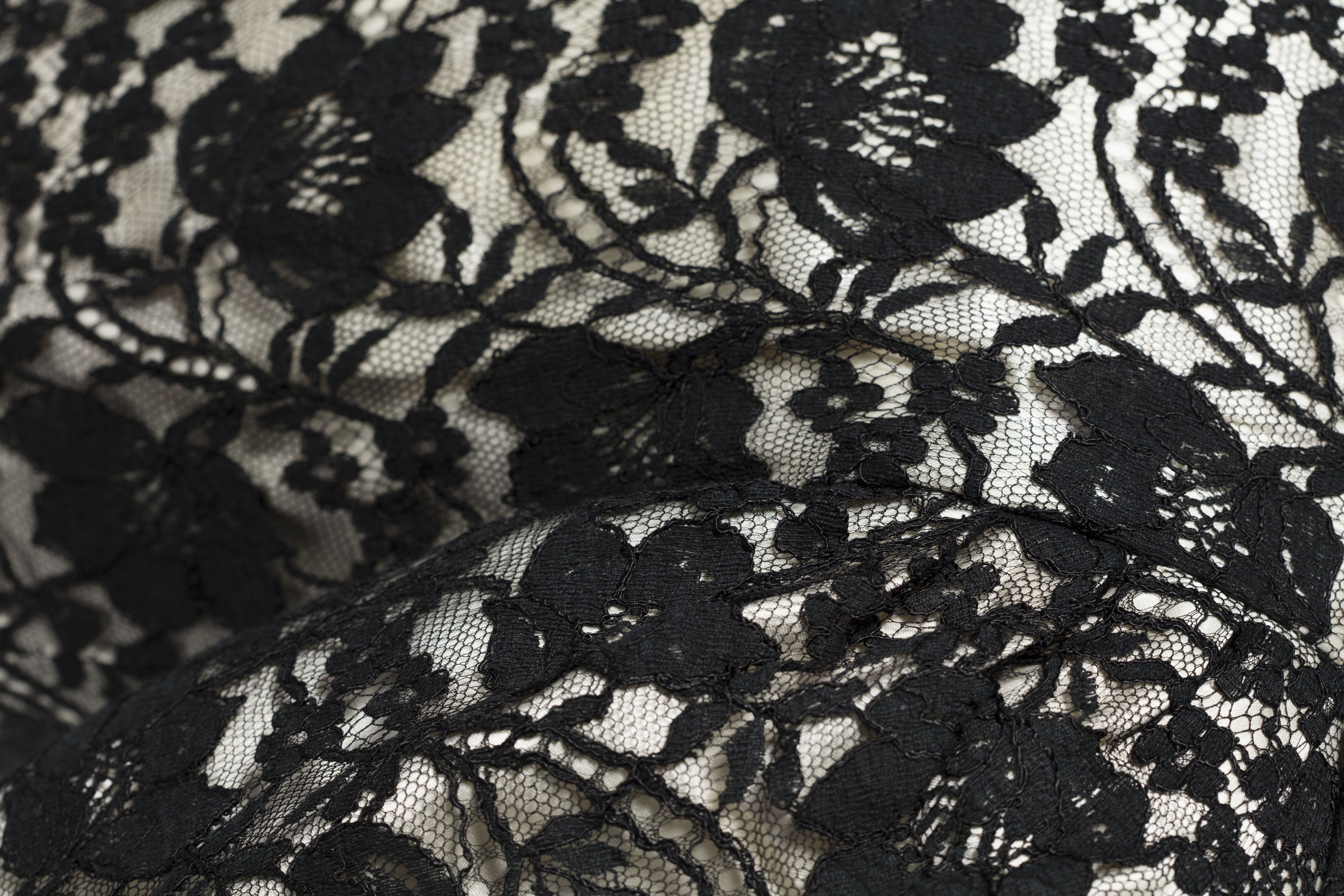
While Moi-Yo Miller was touring the world, back in Australia Esme Levante was preparing for a European come-back of her own.
Her marriage to Robert Butt hadn’t lasted. Now remarried to George Hunt and with her young son Maxwell in tow, in 1954 she joined her parents bound for the UK to restage How’s Tricks in what the Great Levante described as his third world tour.
John Newman and his wife Tikki Taylor were also young performers trying their luck in London and they joined the Levantes on tour.
A popular act in How's Tricks involved a "vanishing kangaroo" - which was actually a wallaby sourced in Britain, reportedly with the assistance of Sir Edward Hallstrom, president of the trustee of Sydney's Taronga Zoo.
Each lunchtime, Newman recalls, Esme would turn heads by walking the animal on a lead through the city streets to nearby factories to drum up audiences for that night's performance.
She also caused a press sensation when, attempting to reprise her underwater escapology act, she was led away from the Palace Pier at Brighton after authorities deemed the conditions too rough for such a daring trick.
Newman says Esme was an accomplished performer in her own right, who "looked like a queen" when she walked on stage. One popular trick involved firing a girl from a cannon on board a ship, but was updated to become a rocket "because rockets were modern day".
"Les came out in a full admiral suit, a blue sequinned outfit. Marvellous! And all of a sudden Esme came out to actually press the gun, and she had a beautiful evening frock of the same blue sequins, and her hair was all done up in diamantes. She was just beautiful."
However despite outward appearances, Esme was struggling with her own ill health. After a stint in hospital for crippling arthritis, she had recovered enough by 1956 to forge a solo career of her own.
For the next decade she would grace the cabaret clubs of Europe under the stage name Esme the gorgeous witch, or Esme the glamorous witch.
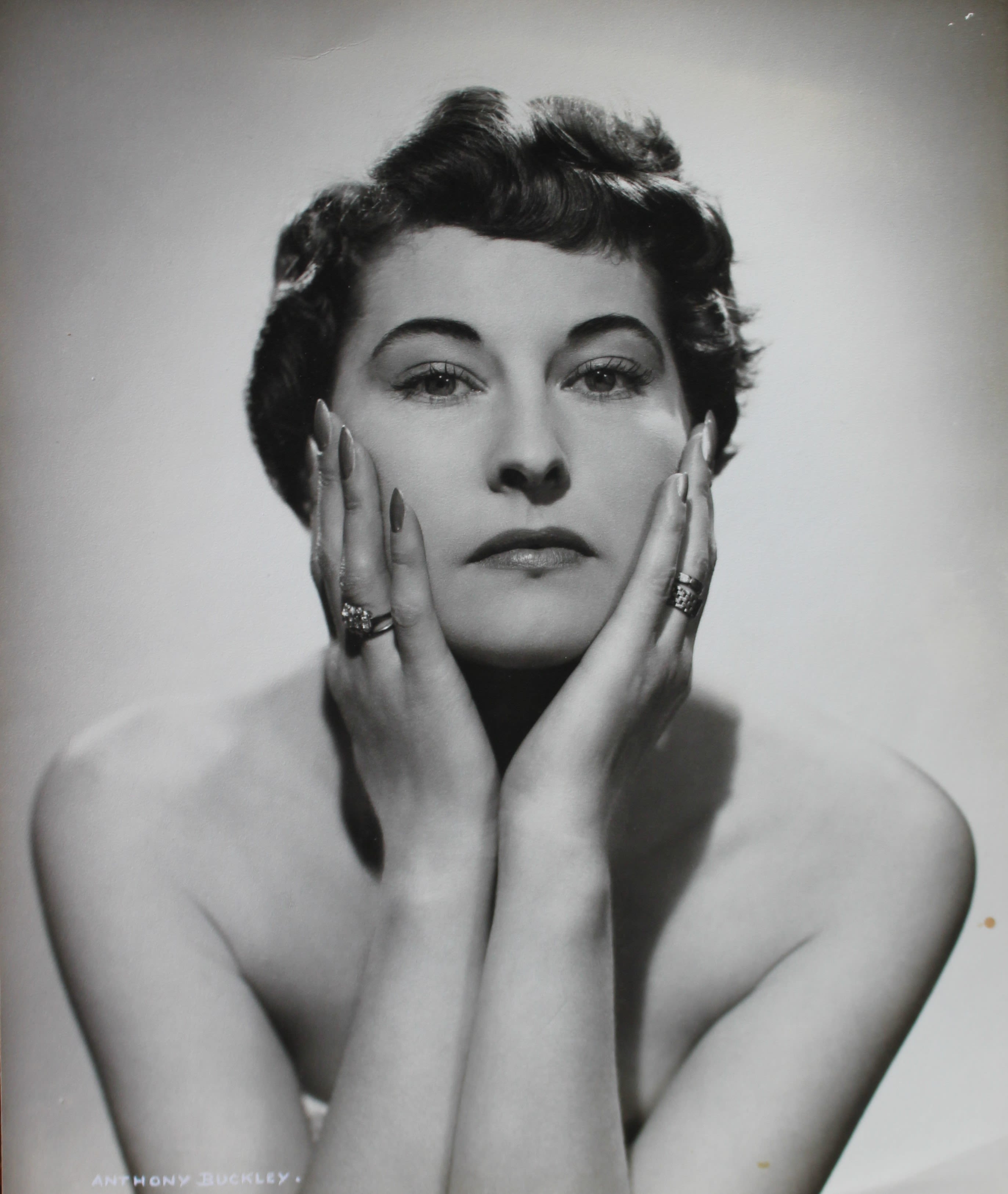
Esme's repertoire was a particular brand of stylish magic. And there was one trick in particular that was her own version of the "vanishing kangaroo".
It was an instant sensation with the press and audiences alike - and a reminder of her Australian roots.
Esme Levante, with her husband George Hunt assisting, on French television in 1960 (Copyright Ina.fr)
Esme Levante, with her husband George Hunt assisting, on French television in 1960 (Copyright Ina.fr)
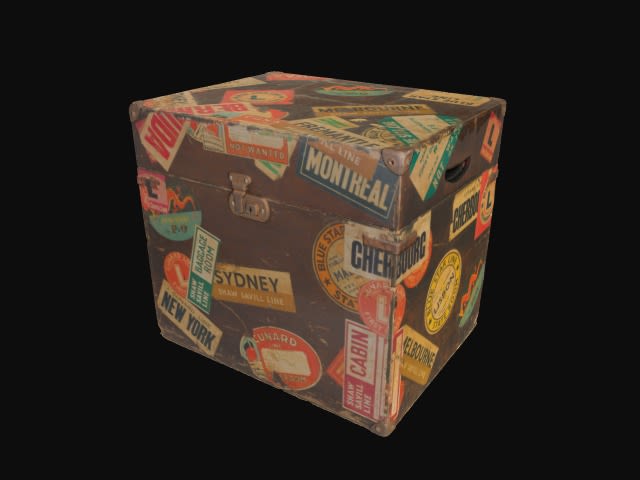
As well as appearing on French TV, she appeared on television in the UK in 1965 to help celebrate the Diamond Jubilee of Britain's famous Magic Circle - a club that incidentally would not admit women into its membership ranks for another 26 years.
Esme's prowess was also praised in Australian Variety News in 1968:
"Esme has appeared in all the major capital cities of the world and her travels have taken her from Moscow to Monaco, Copenhagen to Cairo, Brussels to Beirut, Paris to Pakistan.
"Her delightful London home has been the hopping off place for all her exciting travels and she has presented her act many times before members of the British Royal Family as well as crowned heads of Europe.
"One of Esme's many successful showplaces has been the French Riviera, where the sophistication of the Jet Set in the gay casinos provided an ideal background for an act such as Esme Levante."

Esme Levante by UK portrait photographer Anthony Buckley, circa late 1950s- 1960s (courtesy Maxwell Hunt. Copyright Anthony Buckley & Constantine, London)
Esme Levante by UK portrait photographer Anthony Buckley, circa late 1950s- 1960s (courtesy Maxwell Hunt. Copyright Anthony Buckley & Constantine, London)
After a lifetime on the stage and in increasing pain and ill health from arthritis, Esme Levante retired from performing in 1968. She returned to Australia, retired her stage name in favour of Esme Hunt, and became an artists' agent.
Esme Levante died in Brisbane in 1989, aged just 67 years old.
Myrtle Roberts spent the last years of her performing career working with John Newman and Tikki Taylor in their theatre restaurant in Exhibition Street, Melbourne. She answered an advertisement for vaudeville performers in 1965 and stayed with them for 15 years.
"We had a lot of dancers come in and say 'I can sing' and I said, 'Can you do anything else, can you play an instrument?' 'No, no, no', " Newman says.
"Then all of a sudden this lady came in all dressed in black and she said 'I am Myrtle Roberts'.
"This was the most incredible woman I had ever met in my life. She was a castle unto herself. She lived at Black Rock by herself, she had a huge house down there and she collected everything.
"She used to say 'There is nothing you can't sell, you just have to find the market for it'."
Newman says that Myrtle rarely spoke about her magic career "except she did say she had a tiny little body that she kept tiny so she could fold up into small spaces".
One of her more popular acts with Tikki and John's was donning a nude body suit, painted by Tikki, to become Lydia the Tattooed Lady. She also performed a fan dance, and according to one journalist, played "a racy part in a melodrama".
When her partner died in 1967 after their more than three decades together, Myrtle said that she was so lonely that only performing saved her.
Ever the professional, Newman says "she never missed an entrance, never missed a performance". But he remembers the day she decided to step away from the stage for good, giving a final assessment of a hat made of black ostrich feathers that she had always despised.
"Myrtle slid a note under the door. I read it and it said 'Dear John, I am leaving the show. I have never liked show business people and they have never liked me. And I don't like that black hat'."
Myrtle Roberts died in Melbourne in December 2003. She never revealed her age to the press during her lifetime, but records show she was 95 years old when she died.

Myrtle Roberts (left), with Vic Gordon, Gwendow Paul, John Newman and Tikki Taylor at Tikki and John's in 1967 (courtesy of John Newman)
Myrtle Roberts (left), with Vic Gordon, Gwendow Paul, John Newman and Tikki Taylor at Tikki and John's in 1967 (courtesy of John Newman)
Moi-Yo Miller stepped back from the stage when she had her two children in the early 1950s. She had met her husband Arturo Montes while on tour in Mexico City and he too had joined the Dante show, making and designing illusions.
Dante died in 1955 in California aged 71 after a heart attack. Kininmonth says his death was life changing for her mother and for a while she "just tried to get away". She settled into family life in Santa Clara, California and became a successful saleswoman of jewellery and accessories at an American department store.
Yet her performing skills stayed with her almost to the end.
"She was very able to scrunch herself up into a tiny little space. She could do that when she was 90-something years old, still.
"She never lost that ability."
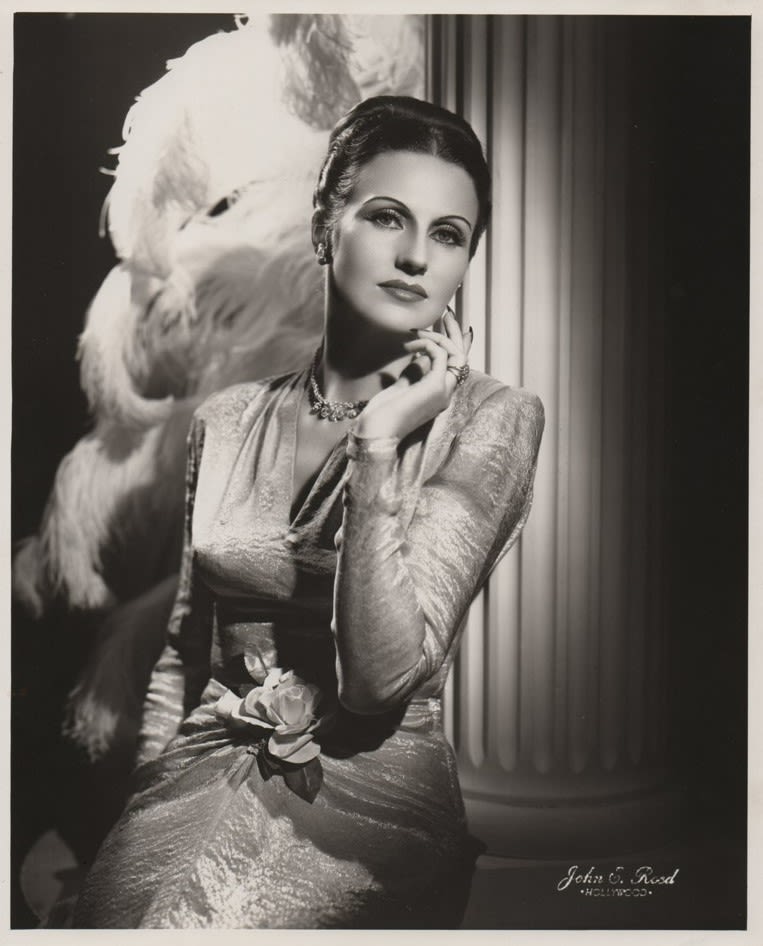
A studio shot of Moi-Yo Miller, circa 1940s (courtesy of Charisse Kininmonth)
A studio shot of Moi-Yo Miller, circa 1940s (courtesy of Charisse Kininmonth)
For many years Moi-Yo lived a life out of the spotlight, but in the last decades of her life she reconnected with the magic community, speaking at conventions and special events about her years with Dante during the golden years of magic.
Moi-Yo Miller interviewed in 2008 for a US documentary about magicians' assistants called Women in Boxes, directed by Phil Noyes and Harry Pallenberg (extract courtesy of Phil Noyes)
Moi-Yo Miller interviewed in 2008 for a US documentary about magicians' assistants called Women in Boxes, directed by Phil Noyes and Harry Pallenberg (extract courtesy of Phil Noyes)
Moi-Yo Miller Montes died in Melbourne in September 2018, at the extraordinary age of 104.
Like Esme Levante and Myrtle Roberts, she left an indelible mark on the history of magic performance.
Much more than a foil to the main act, the careers of these three very different women deserve to be remembered - and their lives and legacies celebrated.
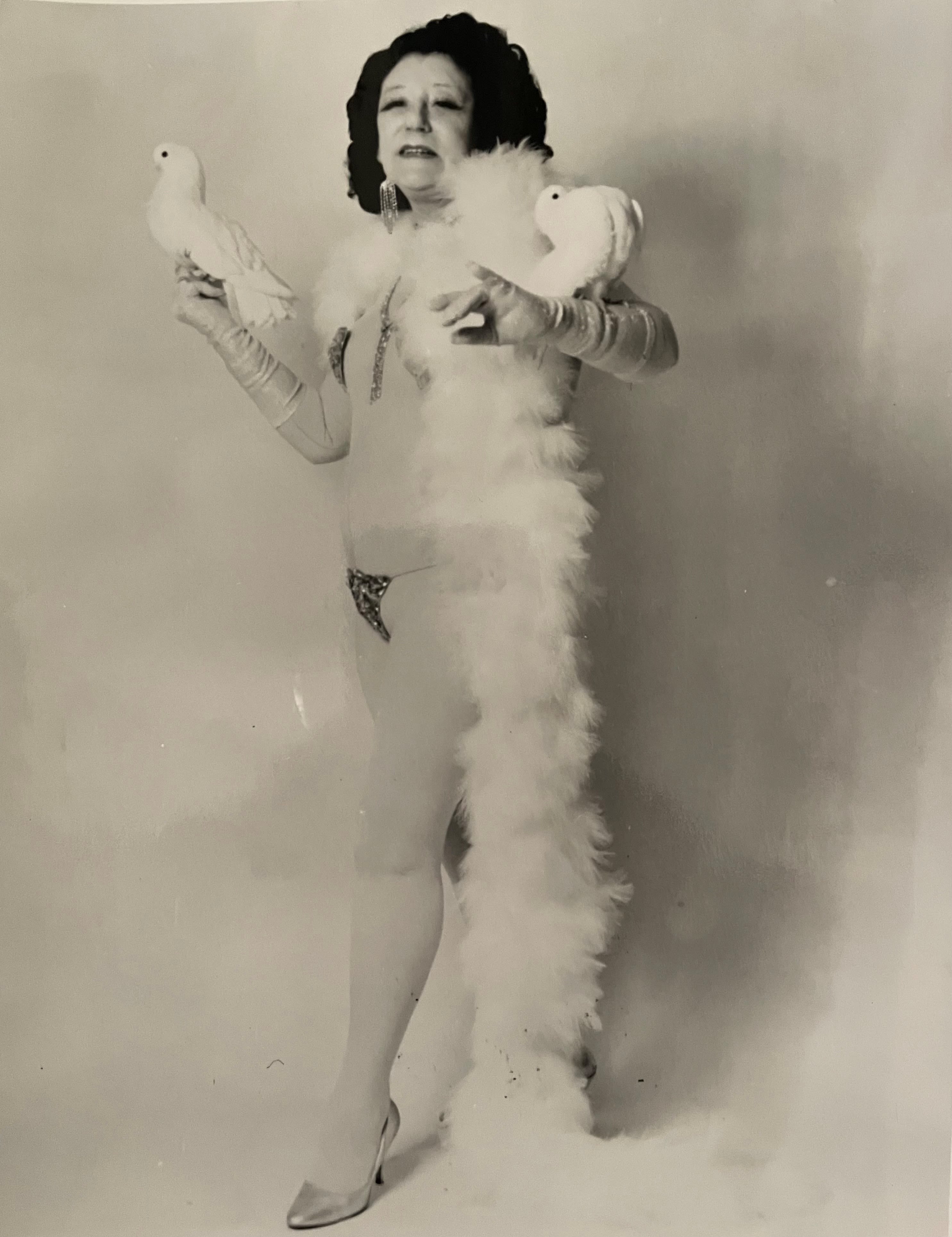
Myrtle Roberts with two white doves, in an undated photograph (courtesy of Pete Smith)
Myrtle Roberts with two white doves, in an undated photograph (courtesy of Pete Smith)
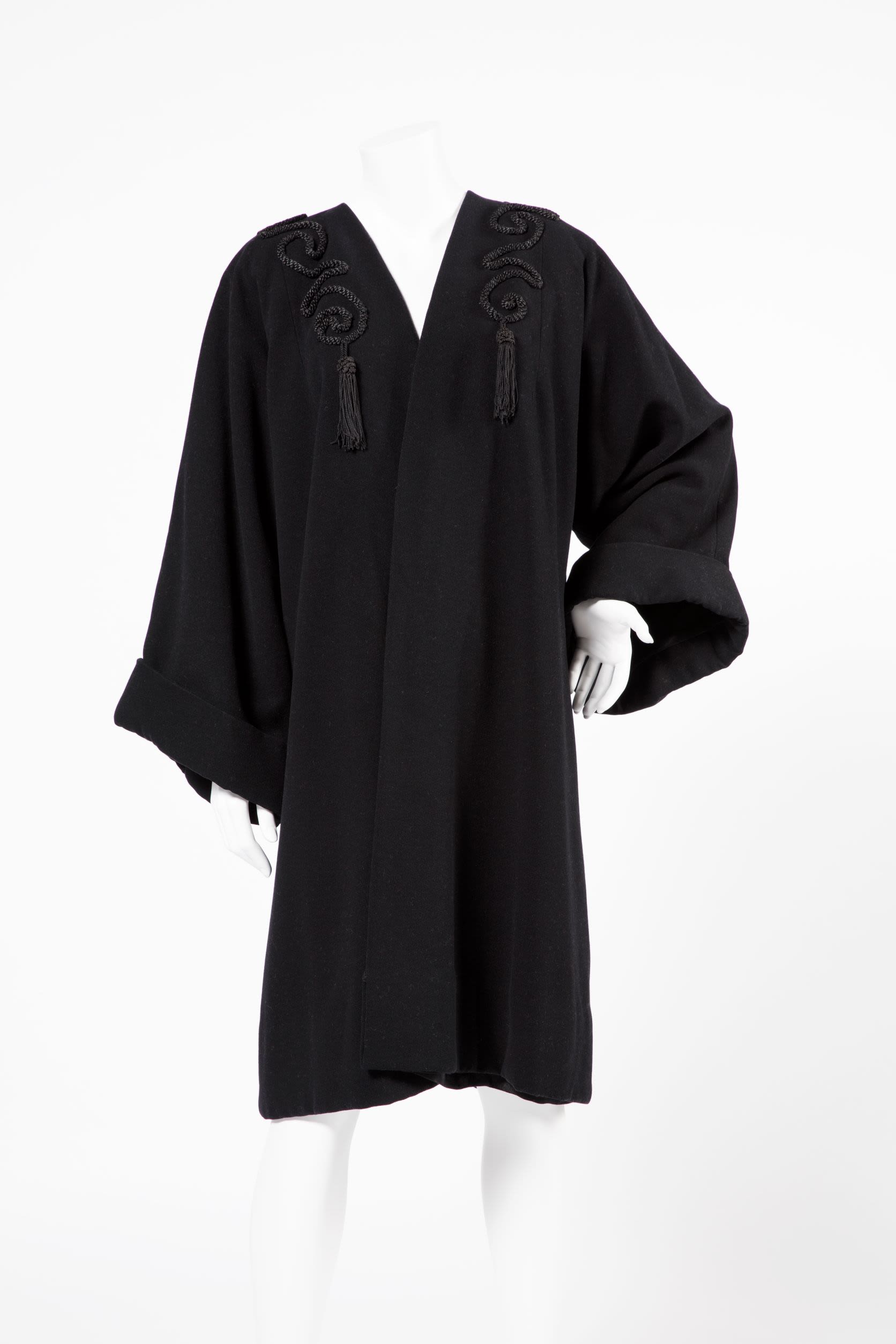
Coat worn by magician Myrtle Roberts, Australian Performing Arts Collection
Coat worn by magician Myrtle Roberts, Australian Performing Arts Collection
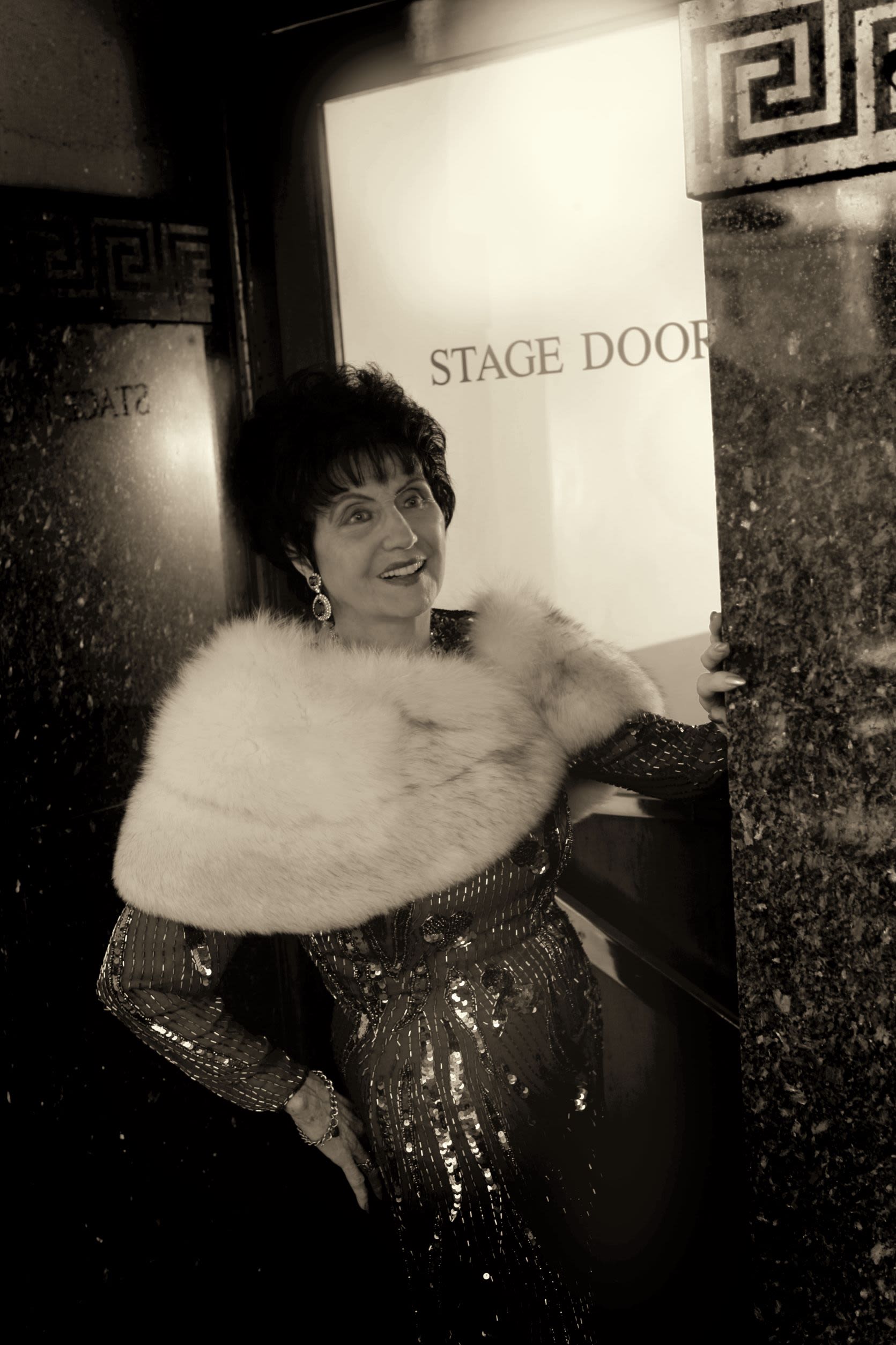
Moi-Yo Miller, aged 92, photographed by Jeff Busby in 2006, the Australian Performing Arts Collection
Moi-Yo Miller, aged 92, photographed by Jeff Busby in 2006, the Australian Performing Arts Collection
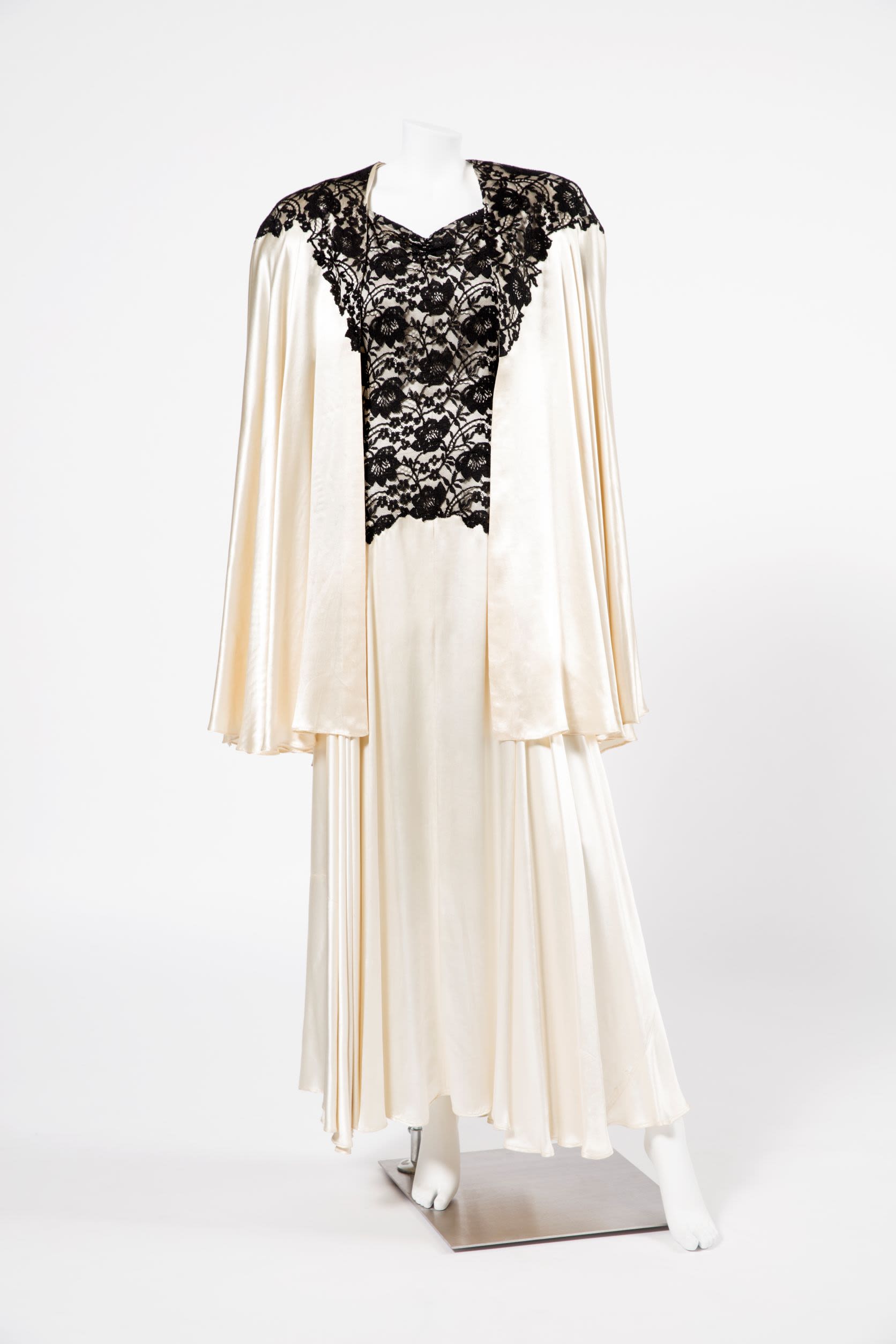
Dress and cape worn on tour by Moi-Yo Miller, 1941-1945, Australian Performing Arts Collection
Dress and cape worn on tour by Moi-Yo Miller, 1941-1945, Australian Performing Arts Collection
Acknowledgements
Rare flowers and golden butterflies was written and produced by Cathy Pryor, 2021 Frank Van Straten Fellow at the Arts Centre Melbourne
Stills photography: Tony Owczarek
3D photogrammetry: S-I Projects
Pedestal 3D: Michael Rampe
Arts Centre Melbourne: Claudia Funder, Ari Hunter and Rowena Craick
Archival footage of Esme Levante at the Malvern Magicians' Convention, 1938, Copyright Reuters/British Pathe, UK
Archival footage of Esme Levante performing in La piste aux etoiles, 1960, Copyright Institute national de l'audiovisuel, France
Women in Boxes, 2008, directed by Phil Noyes and Harry Pallenberg and written by Blaire Baron
Moi-Yo Miller's hat box, statue and portraits courtesy of Charisse Kininmonth; Esme Levante portraits courtesy of Maxwell Hunt; Myrtle Roberts photographs courtesy of Pete Smith and John Newman
With special thanks to Maxwell Hunt, Charisse Kininmonth, John Newman and Kent Blackmore for their assistance with this project.

